Mexico City is a city of contrasts. The world’s largest Spanish-speaking city, it is also the capital of one of the world’s richest countries. The pinnacle of modern architecture paired with ancient historic archeology. The historic district is one of the most vibrant and exciting parts of the city. The historic district is filled to the brim with museums, art galleries, iconic landmarks and amazing shops. It is the only place in the country where you can visit a pre-Hispanic temple, a church from the 17th century and a food scene unlike any other. From the minute I stepped off the plane, I was in love with this area. I was in awe of the bright colours, bustling atmosphere, and ancient architecture popping up from every hidden corner.
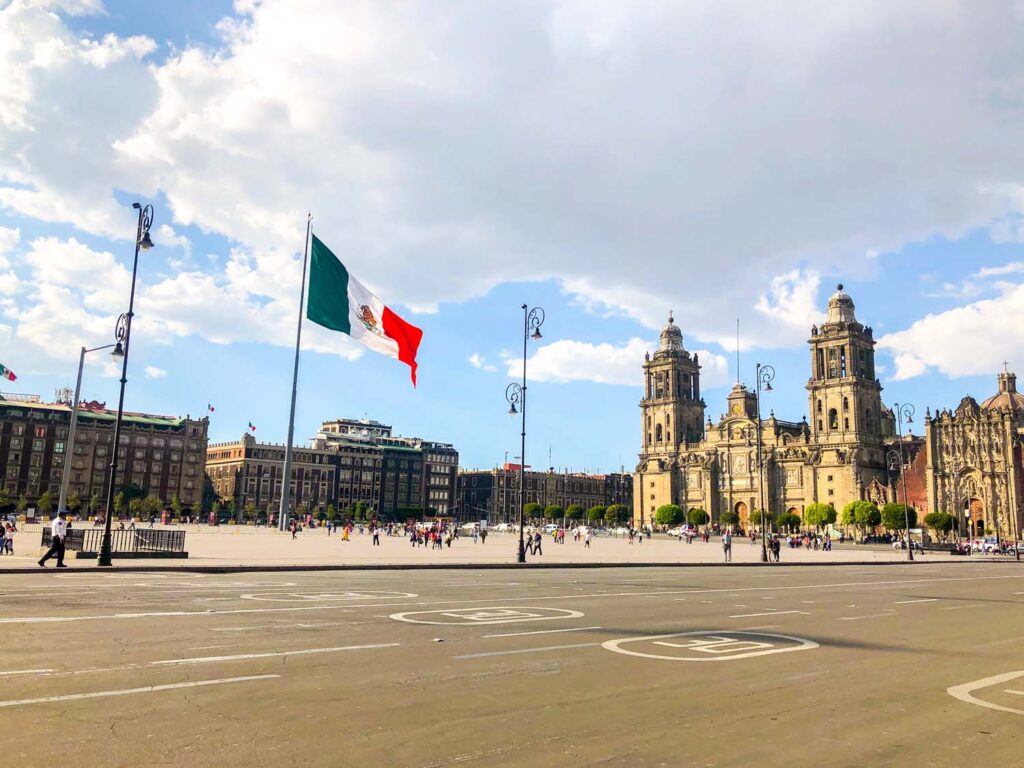
One of the best parts of Mexico City is its sheer size. While some people find this to be a downside, as it might feel overwhelming, I think it’s a huge plus! The various districts and neighbourhoods allow you to feel like you’re visiting a hundred different cities, all in one place. La Condesa is the peaceful botanical garden. Roma Norte is the hipster foodie quarter. Polanco is a luxury shoppers dream. Coyoacan is a bohemian wonderland. Last, but not least, the Historic Center (or Centro Historico) is the place where it all started! The streets in the Historic Center are brimming with ancient and colonial architecture. It is a place of discovery and authenticity. If you’ve never been to Mexico City before, you need to plan on spending at least one full day exploring this part of town.
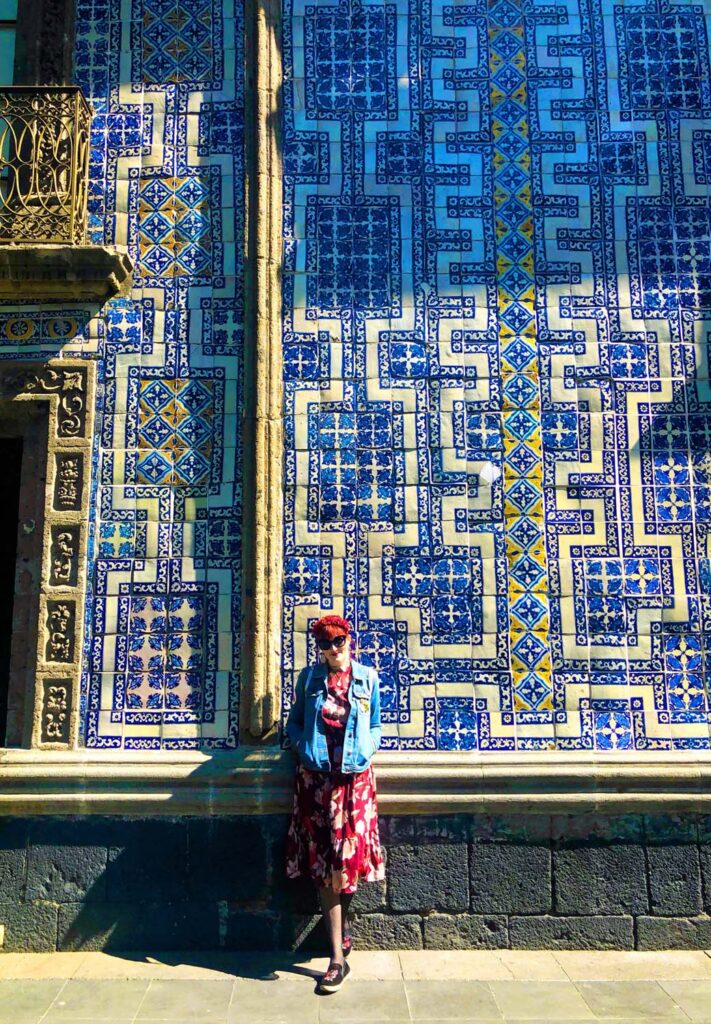
- Access
- Start of the Walking Tour: Alameda Central
- Palacio de Bellas Artes
- Palacio Postal
- Pastelería Ideal
- Torre Latinoamericana
- Avenue Francisco I. Madero
- Casa de Los Azulejos
- Sanborns
- Church of San Francisco
- Palacio de Iturbide
- Taquería Tlaquepaque
- Dulcería de Celaya
- Mexico City Cathedral Metropolitan
- Templo Mayor Museum
- Palacio Nacional
- Zócalo
- Gran Hotel Ciudad de México
- Azul Historico
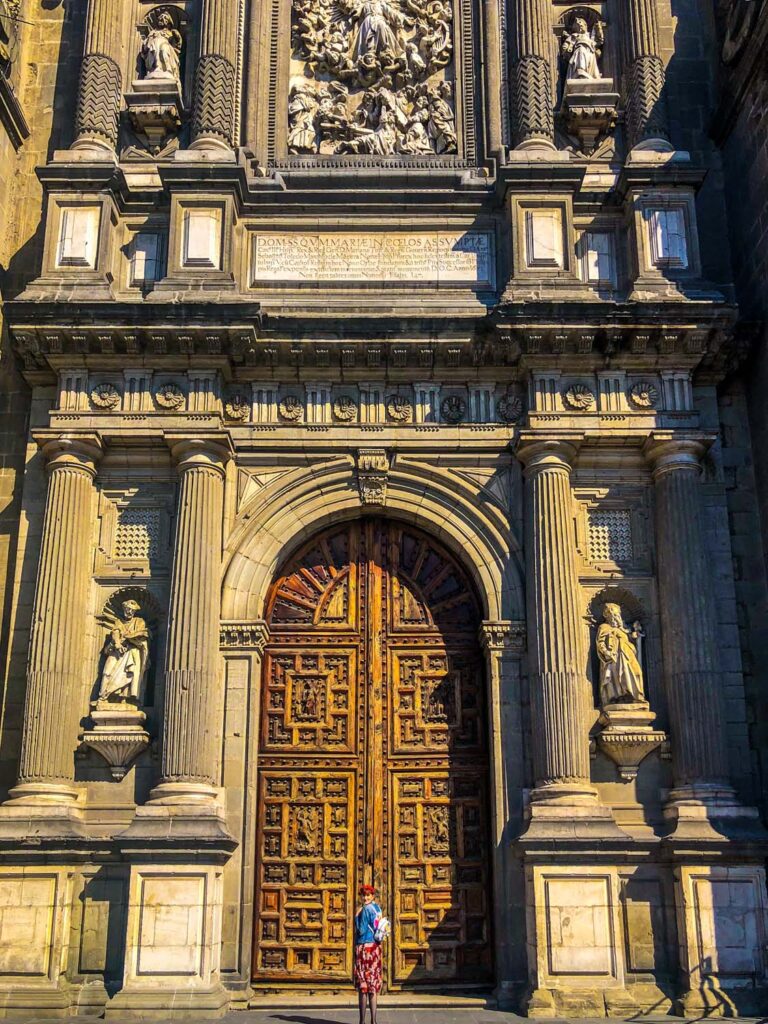
Access
The Historic District is bordered by the Zócalo to the east and the Paseo de la Reforma to the west. Insurgentes and Av. Juárez are located to the north and San Angel to the south. The best way to get around Mexico City (in my opinion) is by using Uber. Not only is Uber extremely safe, but you also don’t need to worry about getting ripped off. Fare are displayed upfront before confirming your ride. There is no fussing for cash either as you pay via a credit card stored on the app.
Rush hour traffic is REAL in Mexico City. Honestly, traffic is pretty dense throughout the entire day but it’s definitely worse before and after work hours. I would advise arriving at our starting location before 9 am. This ensures you don’t have to deal with too much of the rush hour traffic.
There is also a metro station located right near our first stop. If you prefer to take public transit, that is definitely an option as well. The Metro in Mexico City is SUPER cheap and surprisingly easy to navigate. However, it is also hectic and crowded. The safety of the Metro system gets a mixed reputation. For the most part, I generally recommend Uber to ensure you have the most stress-free experience possible. But if you decide to ride the metro just use all the safety tips below.
Be a Smart Traveller
- Don’t wear flashy jewellery or carry expensive handbags
- Keep your money in discreet, zipper pockets and don’t carry too much at one time
- Leave your passport in a safe at the hotel
- Stick to busy streets, well-lit streets
- Ensure your phone plan covers mobile data usage in Mexico. This is a lifesaver when it comes to calling a taxi or just using directions on google maps
- Avoid wandering around at night, instead, take a Uber from location to location
- Avoiding talking to strangers who approach you on the street. Often these are scammers either trying to distract you while they swipe your wallet or just sell you on something sketchy. Kindly just wave them off and continue walking on your way
- Someone strange won’t leave you alone? Walk inside a busy shop
- If you EVER feel unsafe, just call an Uber and you can get picked up and brought to somewhere familiar
- Skip the street taxis and use Uber or other car services instead to ensure a safe ride and reasonable price
- Avoid high-crime areas like Iztapalapa, Tepito, La Lagunia, La Merced, Doctores and Ciudad Neza
- I always carry a photocopy of my I.D. on me in case of emergencies
- Learn a bit of Spanish, goes a long way in many different scenarios
Start of the Walking Tour: Alameda Central
Start your tour as early as you can manage inside the green acres of Alameda Central. This incredible urban oasis is the largest and oldest public park in the Americas. Despite being flanked by busy streets on all sides, when you are wandering inside the gorgeous green canopy of the park’s forest, you feel completely at peace.
History of Alameda Park
The site where the park now stands was once the location of the ancient Aztec marketplace. Today, you’ll still find different vendors bringing out their food carts serving tourists and locals alike. I feel like that same marketplace energy still exists here, just in a slightly different form.

The name for the park comes from the Spanish word “álamo,” which means “poplar tree.” Hundreds of these álamo trees were planted in the garden in 1592. Viceroy Luis de Velasco II ordered the creations of a new public green space for the city’s residents during the start of his regime. He saw the popularity of public green spaces in Europe and wanted the same criteria for his new city.
While the eastern portion of the park was for leisurely promenades, the west end of the park held a more nefarious purpose. This western section was originally built during the Mexican Inquisition. It was known as the “Burning Place.” It was here that convicted witches and people accused of treason were publicly burned at the stake. While you don’t immediately think of Mexico as a place of witch trials, these inquisitions spread worldwide. When the inquisitions ended in 1770, the burning plaza was destroyed and transformed into an extension of the park.
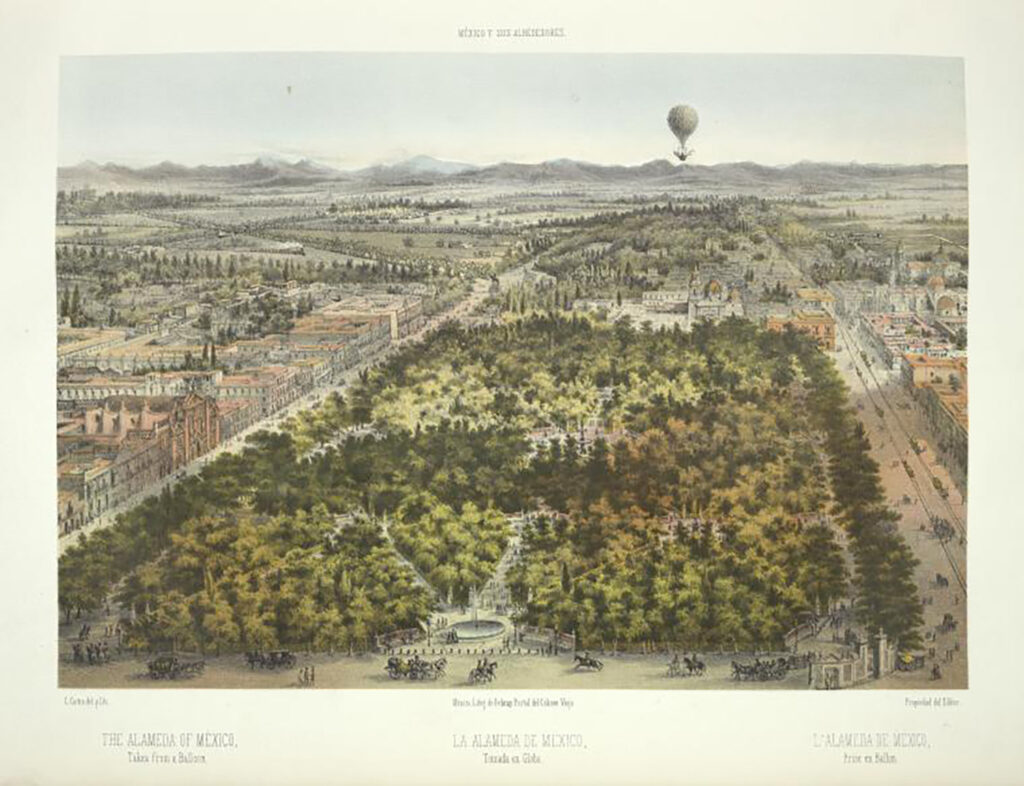
Park Monuments
Like many of the amazing parks in Mexico City, they are more than just trees. The precisely paved pathways lead you around decorative fountains, beautiful statues and incredible monuments. It feels like wandering around an outdoor art gallery. Each of the five fantastical fountains found throughout the park was made in France and were inspired by Greco-Roman mythology.

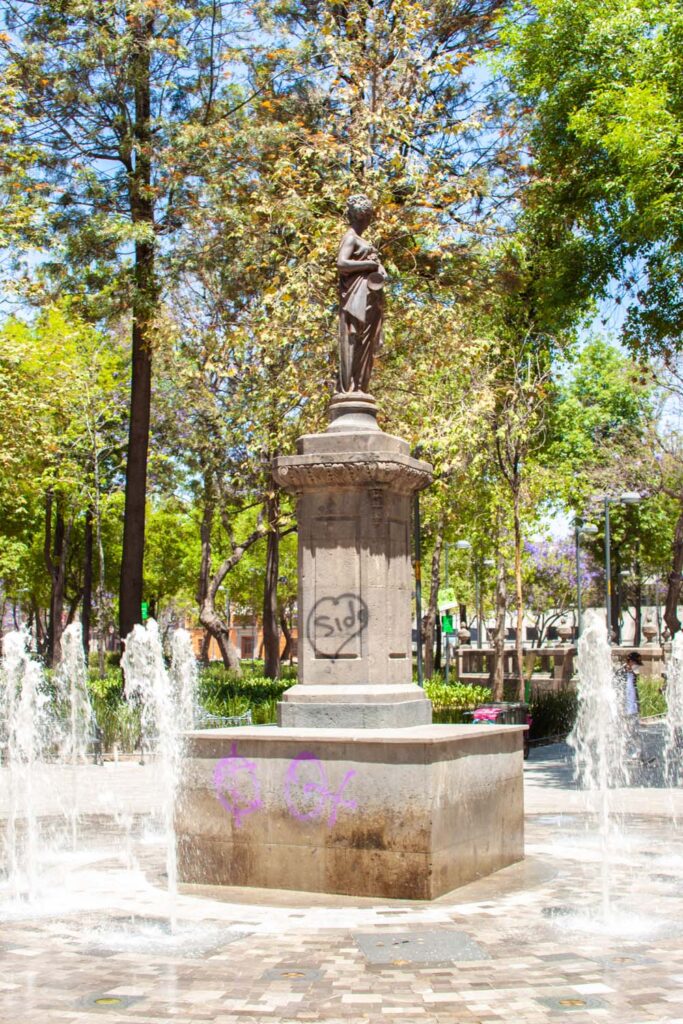
One of the most important monuments is the “Hemiciclo de Benito Juárez.” This large semi-circle of eight towering marble columns with a central plinth is topped with a group of neoclassical statues. In the center is statesman Benito Juárez himself. Juárez was the 26th president of Mexico and, most importantly, the first president of Mexico who was of indigenous origin. On either side of him are two allegorical female statues representing the fatherland and law. On the pedestal he sits, you can see the inscription “Al benemerito Benito Juárez la Patria.” This translate into “To the meritorious Benito Juárez, the Homeland.”
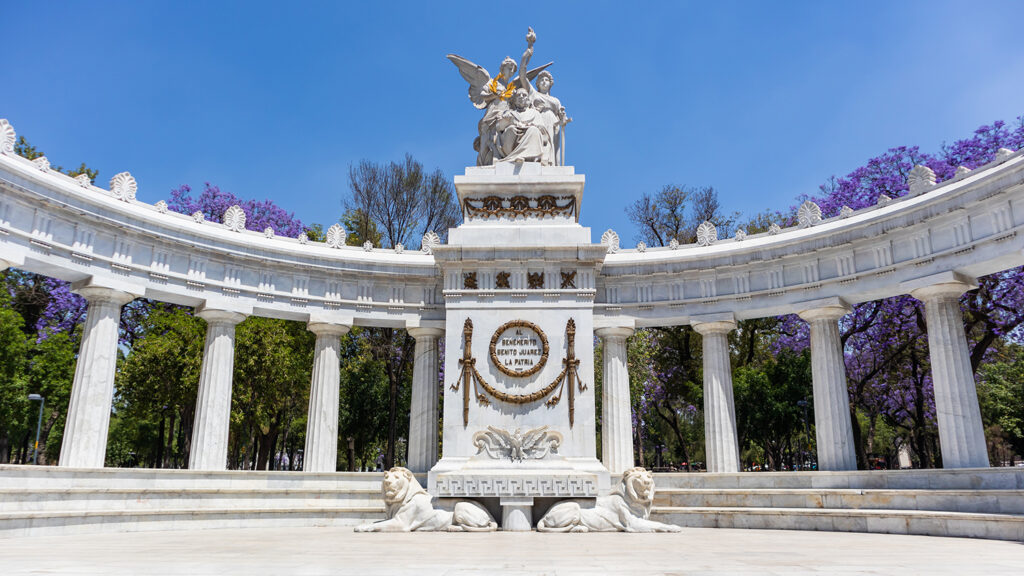
Over the years, the park has been of such important significance to the people of the city. Most importantly, the park was immortalized by Mexican artist Diego Rivera in his famous work Sundays on the Alameda Central. The mural depicts famous people and events in the history of Mexico, all together in one giant vibrant mural. You can still see this mural in the Museo Mural Diego Rivera ocated in the west end of the park. We won’t be stopping in there today, but later in the tour, we will see hundreds of paintings by Rivera located in-situ where they were first painted.
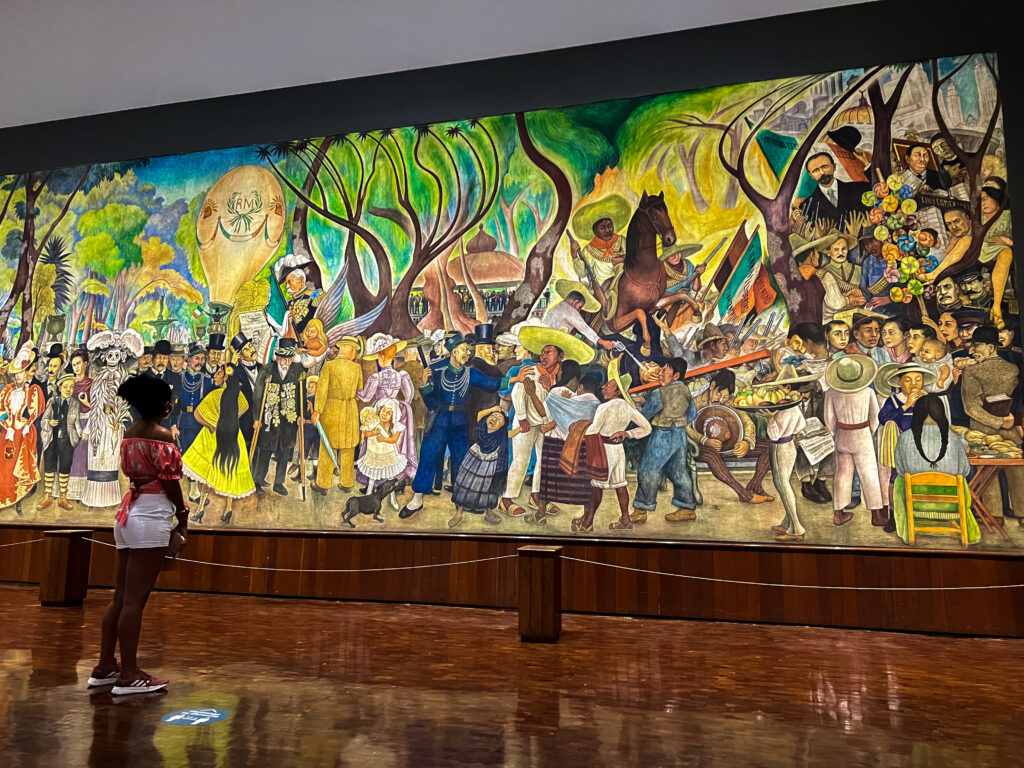
Palacio de Bellas Artes
Right next door to Alameda Park is the fantastical Palacio de Bellas Artes. The Palacio is doubtlessly one of the most impressive buildings in the historic district. Inside, you can listen to international symphonies, watch emotional ballets, become entranced by the theatre, awe at opera and even hear literature performances. Being a hub for all these performance arts gives the building its nickname, “the Cathedral of Art in Mexico.”
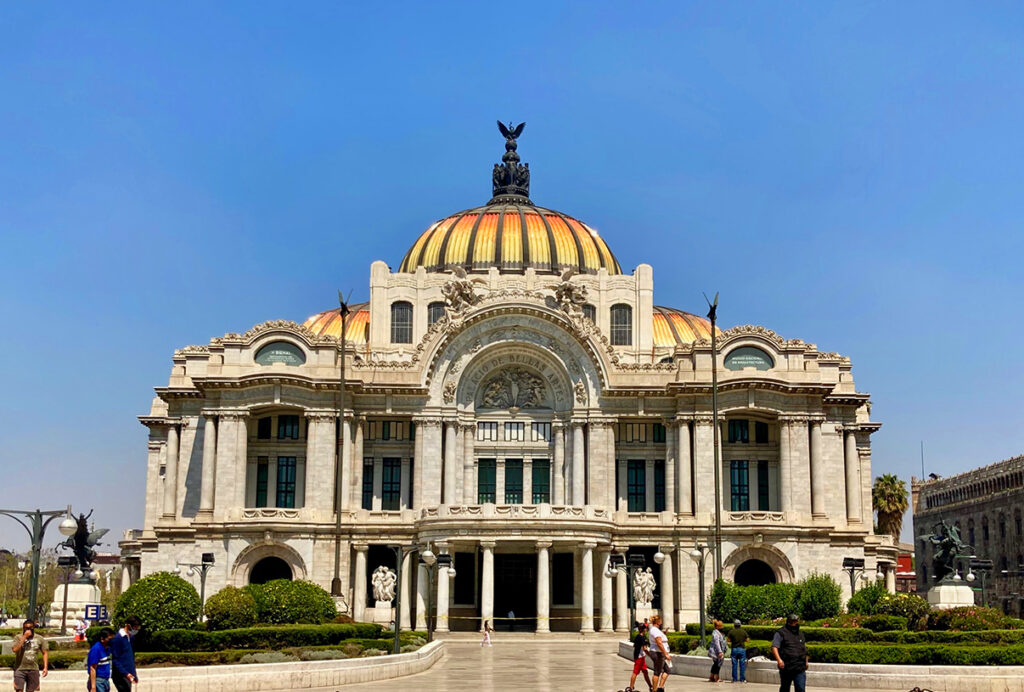
Architecture
The Palacio de Bellas Artes’ original design was conceived by Italian architect Adamo Boari. Boari wanted to create an entirely metallic structure, like the modern skyscrapers popping up in America. He loved the neoclassical and art nouveau styles as well and wanted the facade to follow those principles.
Although Boari started work on it in 1904, the building wouldn’t be completed until 1934. Problems with the soil and political unrest all contributed to halting any real progress. The situation was so volatile that Boari ditched the project and fled back to Italy. Mexican-born architect Federico Mariscal took over construction. Mariscal altered much of the design. The most substantial was the abandonment of the steel exterior. Instead, Mariscal used more traditional materials such as stone and carrier marble. But stone and marble are heavy and contribute to the fact that the poor Palacio is sinking into the soft ground a little more every year.


The Facade
The design of the facade is heavily influenced by classical European styles. The images and references don’t have any connection to the Mexican people or their culture. Despite the fact that the new architect was Mexican, he couldn’t change much of the exterior’s plan as the materials had already been purchased. But when we step inside, we can see Mariscal’s real vision for his Palacio.
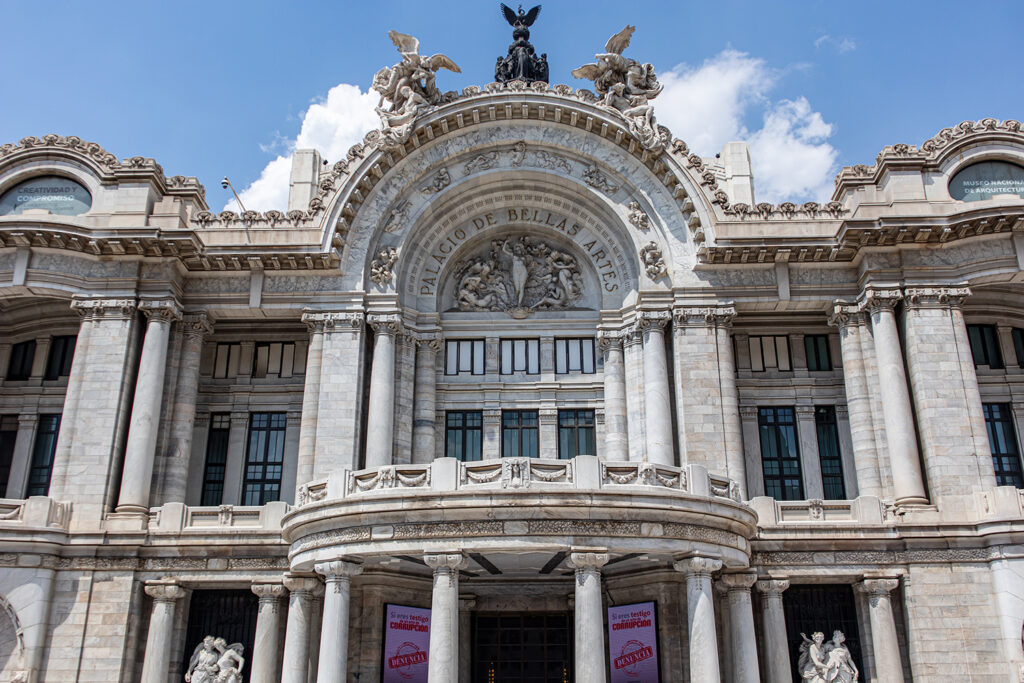
Walking up to the Palacio, you can see four statues of the pegasuses being ridden by the four muses with Apollo in tow. Initially, these statues used to sit on top of the building. Their weight contributed to the sinking of the building, so they were removed and placed on the ground in the gardens surrounding the Palacio.
Inside the portals on the ground floor are a series of Italian sculptures. Each one depicting various allegorical figures relating to emotions that theatre and art aims to invoke in the viewer. Harmony, pain, rage, happiness, peace and love are all featured here in their mortal form.

One of the most impressive features of the building is the rainbow-hued rooftop cupola. This brightly coloured feature feels so appropriately Mexican, as they embrace colour whenever they can. It stands in such contrast to the white marble exterior designed by the Italian.
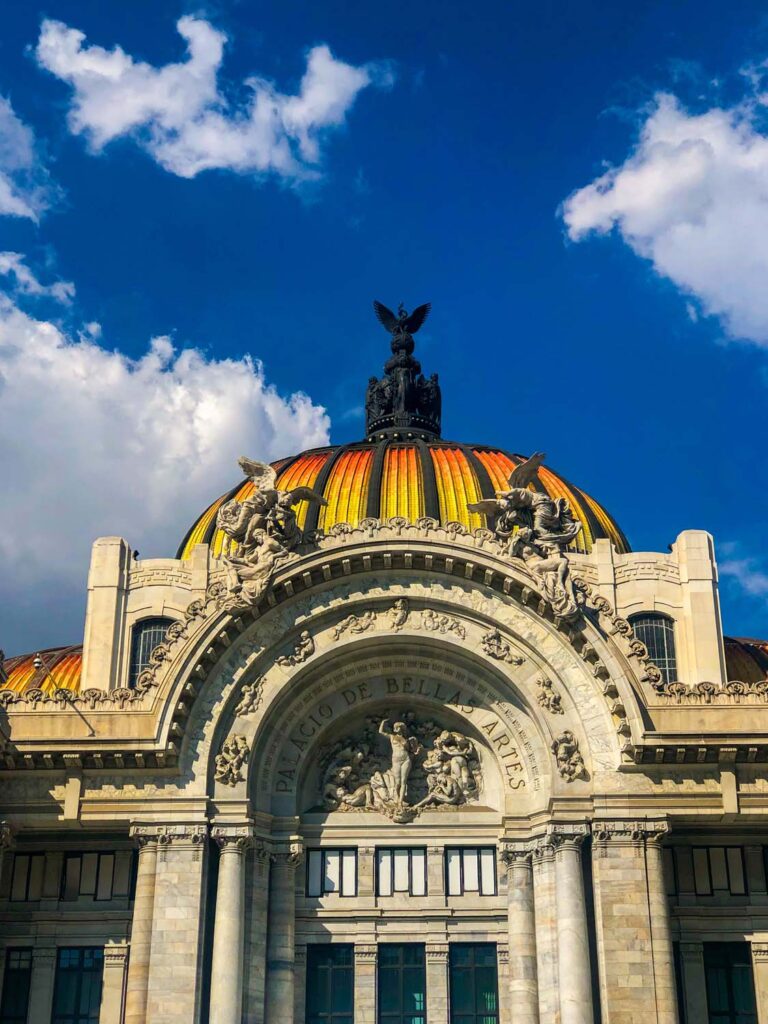
Interior Design
When you walk inside (which you can do for free if you just want a peek into the lobby) you can see the powerful Art Deco style that Mariscal dreamt up. Crawling up the sides of the building are sprawling murals surrounded by prehispanic motifs. You can see serpent’s heads curling around the window arches. Mayan deities and their masks, face out on the vertical columns. Even the marble inside is starkly different from the exterior. This marble is a darker and has a red hue giving the interior a more colourful appearance.
On the second floor (if you take a guided tour) you can see the incredible murals painted by José Clemente Orozco, David Alfaro Siqueiros, Diego Rivera, Jorge González Camarena, Roberto Montenegro and Manuel Rodríguez Lozano. Outside the entrance to the amphitheatre are more bronze carvings of the Aztec and Mayan gods Tlaloc and Chaac (the gods of thunder and rain.)
Inside the auditorium, you can study the 200-foot Tiffany glass curtain designed by Mexican artist Gerardo Murillo aka “Dr. Atl.” The glass design represents the volcanos Popocatépetl and Iztaccíhuatl. Surrounding them are images of the Mexican landscape. But to me, it is the heavenly sky above the landscape that is the most powerful aspect of the piece. The opalescent blues shimmer like the rainbow as the light catches it.
Interior Tour
Everywhere you look in the interior, there are artful representations of the Mexican people, their values and cultural references. It is 100% mandatory to poke your head inside to really soak in the views for yourself. If you just want to peek inside, the cost is free, but you’ll only be able to explore the lobby. The price of admission to the entire building is $60mxn per person + $30mxn camera fee if you want to take pictures. Usually, the line-up to get inside is very long, so if you have your heart exploring the interior, the earlier you get here, the better.
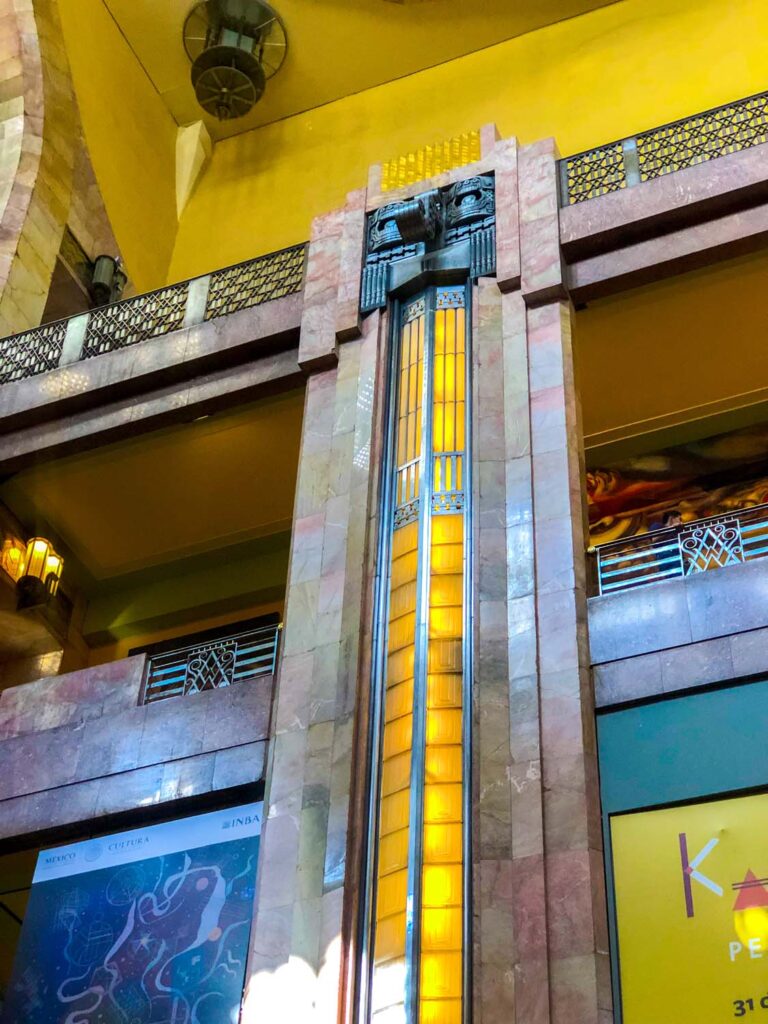
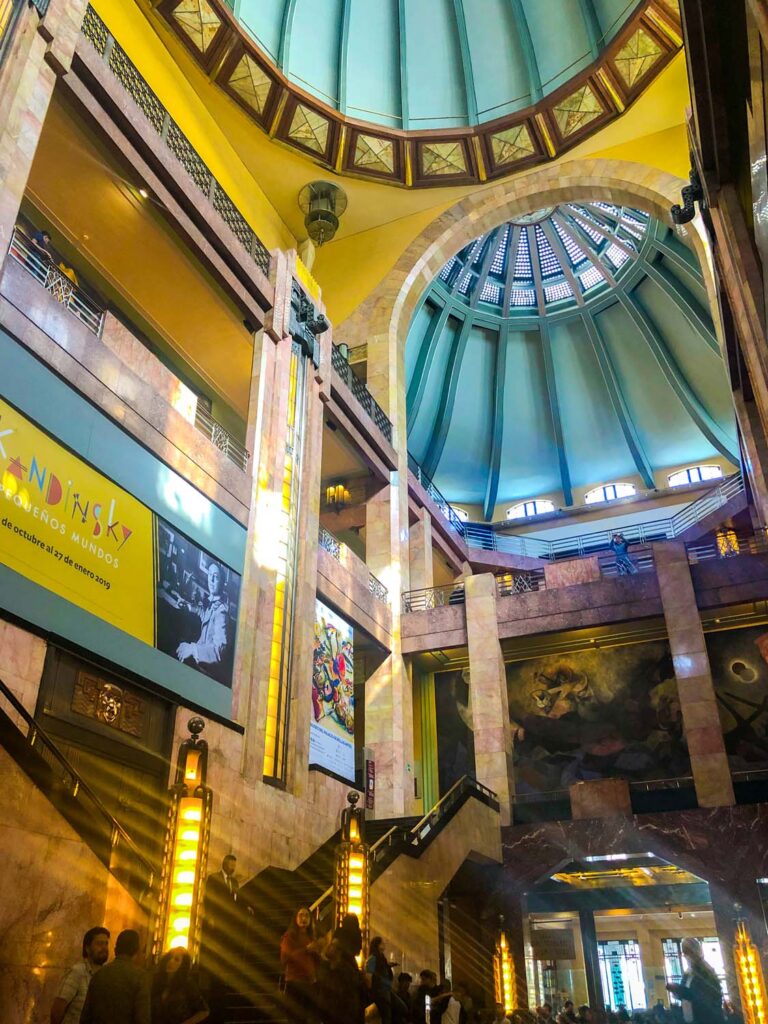
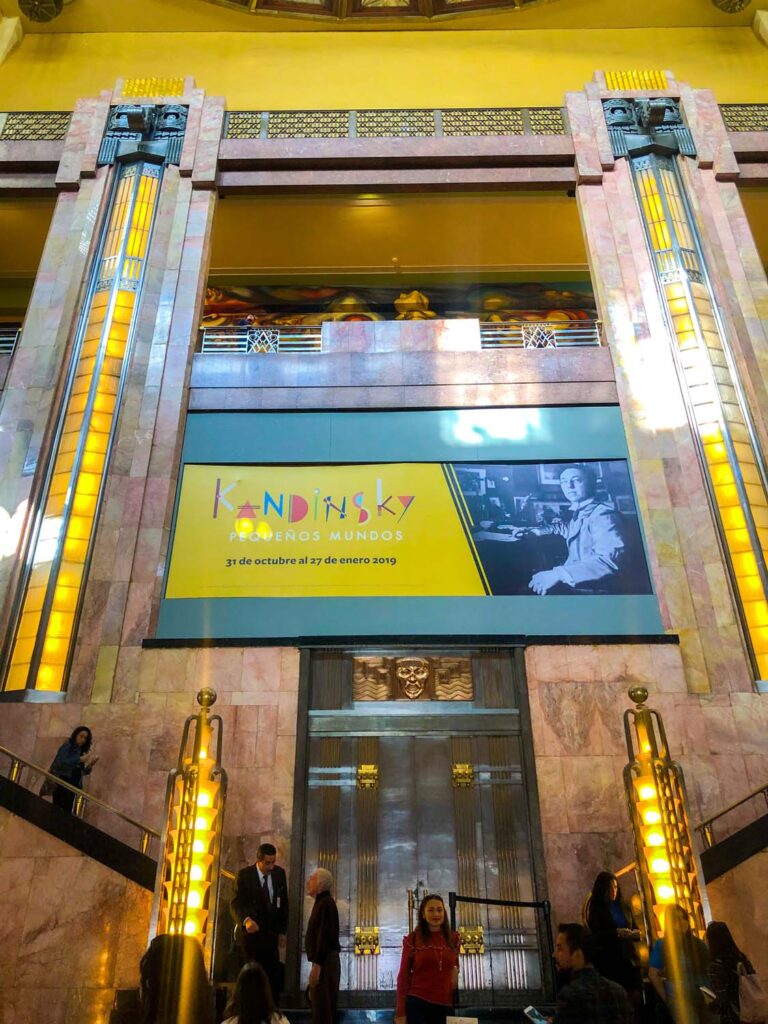
Palacio Postal
Directly across the street from the Palacio de Bellas Artes, you can admire the exterior of the Palacio de Correos de México (Postal Palace of Mexico City.) While it might seem strange to visit a post office, this one is truly spectacular. The Postal Palace of Mexico City was designed when the post office became a separate government entity. They wanted to show off their power and created a building with a very eclectic style to make it really stand out! It blended Art Nouveau, Spanish Renaissance Revival, Spanish Rococo style, Elizabethan Gothic, Elizabethan Plateresque and Venetian Gothic Revival all together. The architect of this Frankenstein creation was none other than Adamo Boari, who designed the Palacio Belles Artes. While you’d think trying to blend that all those styles together would result in a mess, it is anything but!

Construction started in 1902, and the building was finished in 1907. Although five years might seem like a while these days, for such a massive undertaking in the early 1900s it seems almost too quick! The frame of the building was designed on a grid of steel beams. This modern inner structure is why the Post Office managed to withstand many of the earthquakes that destroyed other buildings in the area. Military engineer Gonzalo Garita y Frontera supervised the construction of the steel frame. It is perhaps for this reason that the structure is so sound.
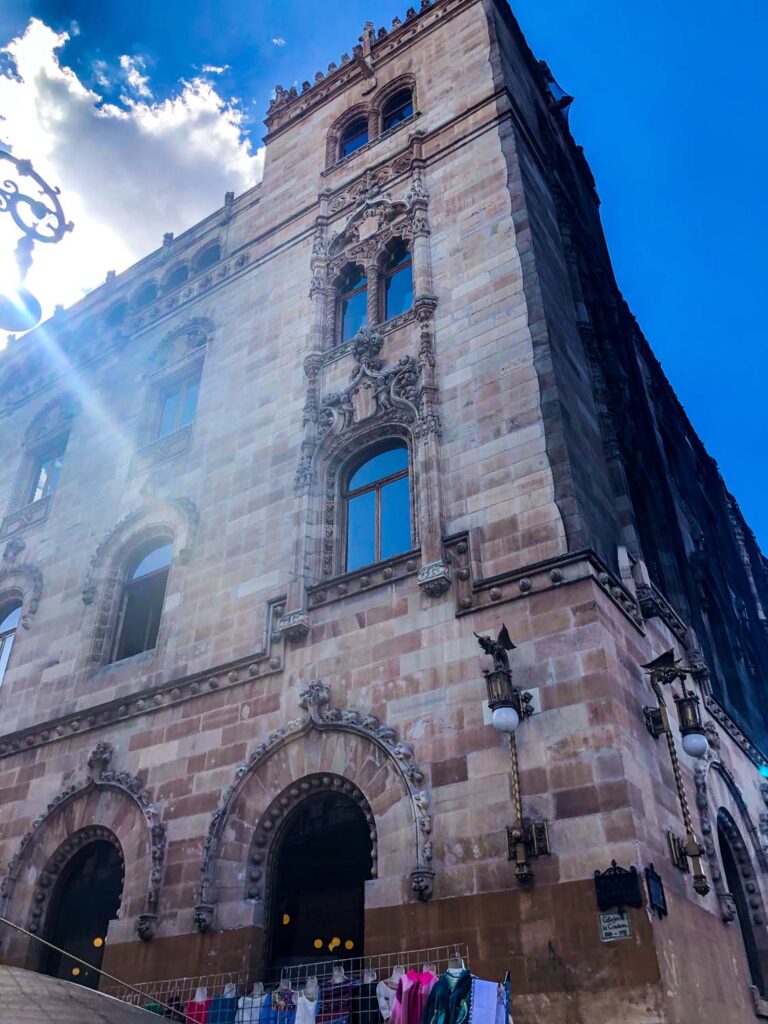

Exterior
One of the most iconic parts of the building is the colour of the stone. The stone is called “chiluca,” which has a slightly translucent effect and is exceptionally light in colour. This allows the heavy ornamentation to be juxtaposed by the airy feeling of the stone. The chiluca stone was quarried from the local Tulpetlac mines. This gives the building a bit of local flare despite the overall European-inspired architectural elements.
Decorating the facade is a mixture of Elizabethan Gothic styles. This period in architecture was dominated by twisting columns, heraldic elements, flowery crests, stone cherubs holding scrolls, gargoyles, hundreds of arches and hundreds (if not thousands) of ornamental balls. Highly polished brass and iron dragons, hanging off the side of the building, shine in the sunlight as you walk along the exterior.
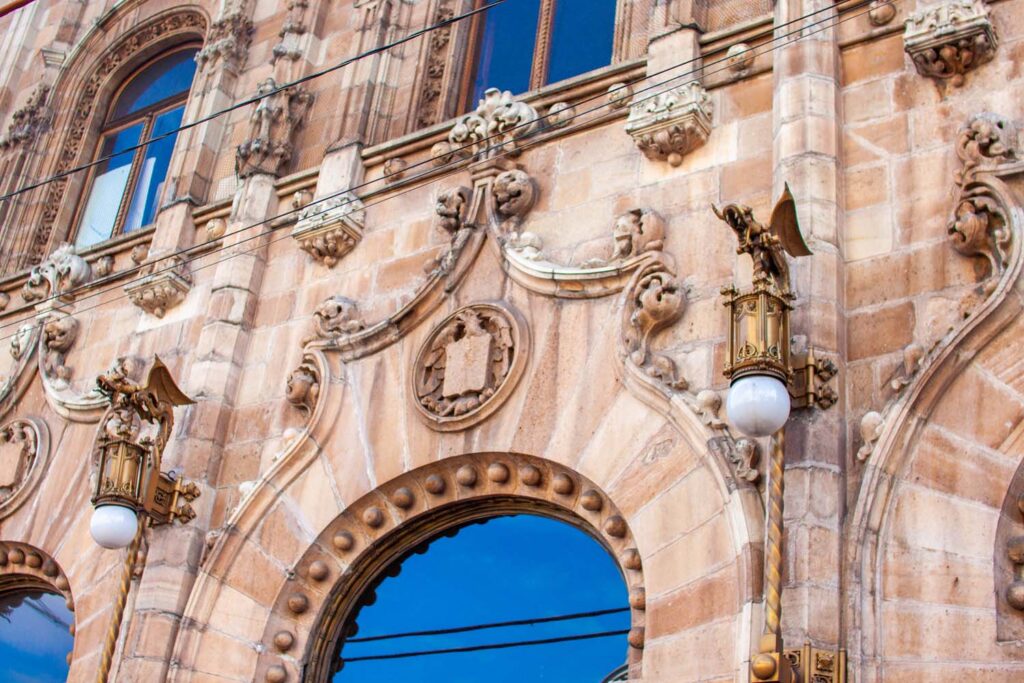
One of the interesting details of the building is the windows that look out onto the street. Take a closer look and you’ll see that the windows on each level are all different designs. Each of these unique window styles is set inside a familiar arch. This gives the facade a more cohesive appearance despite all the different things going on.

Interior
Stepping inside, you are immediately taken aback. Just like the exterior, the interior is awe-inducingly covered in ornamentation. Filigree cresting surrounds the entire building like a living piece of ivy, spreading out from every corner and growing out of control. The marble floors glimmer and shine. They are polished to the point of looking like a mirror, so they reflect the radiant bronze ironwork on the window frames and staircases.
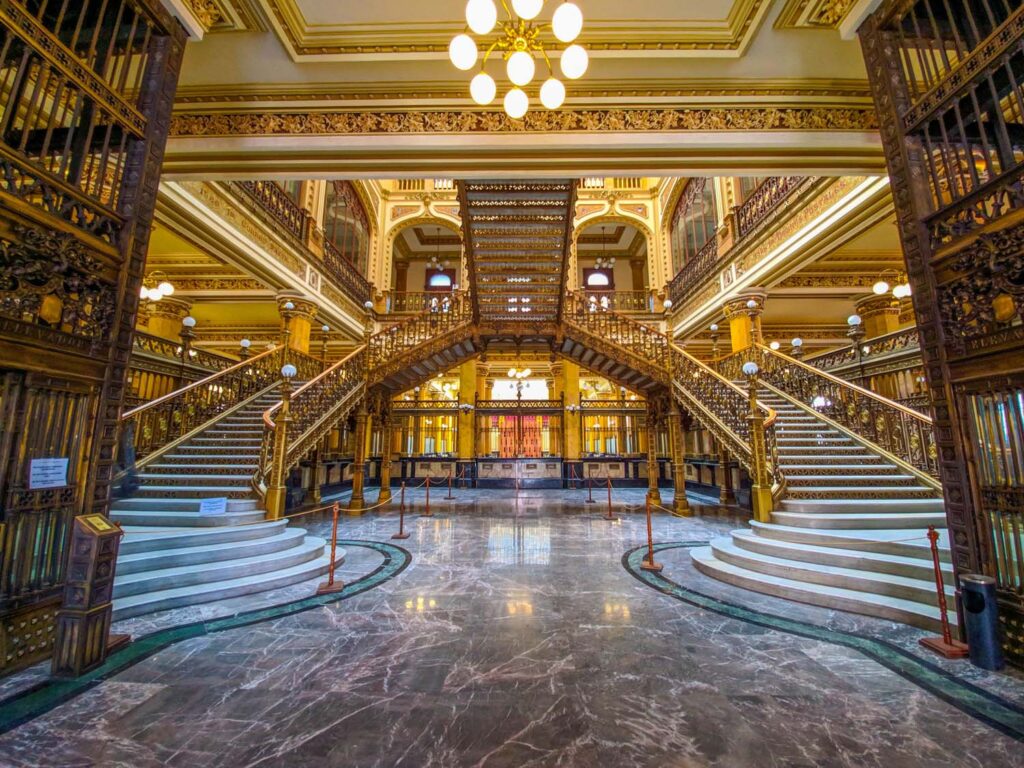
The main staircase descends down from two different directions from a central landing. The stairwell is bathed in bright sunlight from the large leaded glass dome that caps the top of the building.
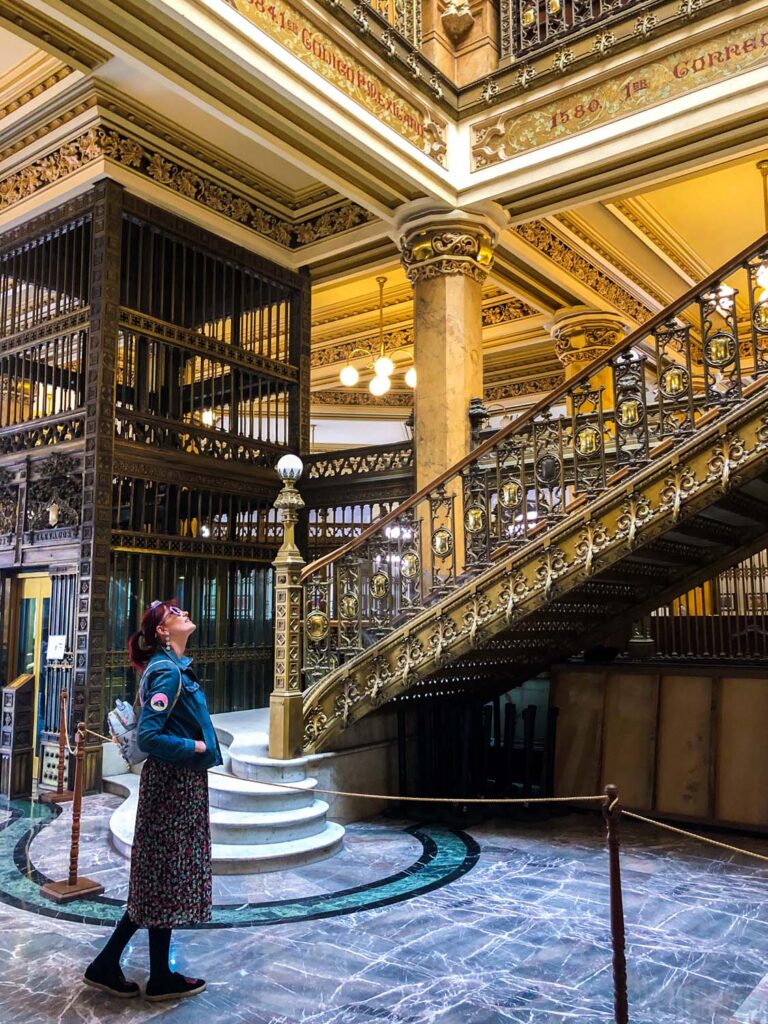
Facing the staircase are a series of shields that crown the finishes of the interior arcade. These shields represent the various countries that were part of the Universal Postal Union at the beginning of the 20th century. This building is so iconic to Mexico that it inspired the design for the “Department of Family Reunions” in the Pixar film Coco.
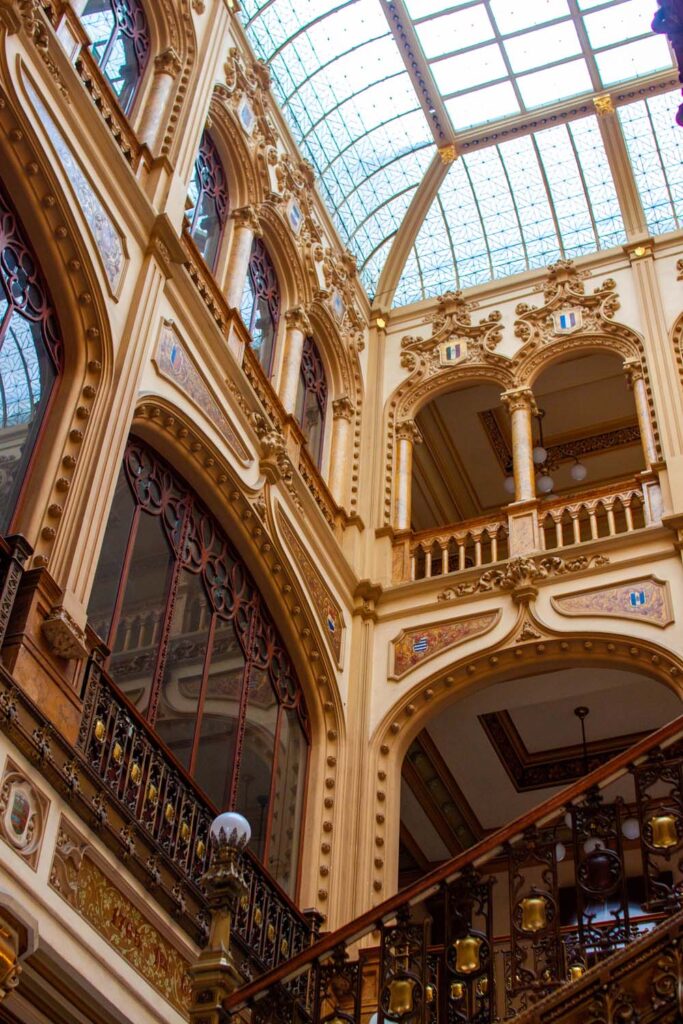
Pastelería Ideal
For the perfect breakfast, especially for those on a budget, head over to Pastelería Ideal. This bakery is one of the most popular shops in the district. In fact, you might have even seen their colossal blue and white boxes all over the city. Many coffee shops around town buy their sweets directly from this bakery. So come morning, delivery services speed thousands of pastries around town. The bakery was founded in 1927 and has been opened in this very spot ever since. They have since opened up three other locations, but this is the original. The building in which it is located was actually once a part of an old Franciscan monastery! You can still see details of the original walls of the De Profundis Room inside the upper floors of the bakery.
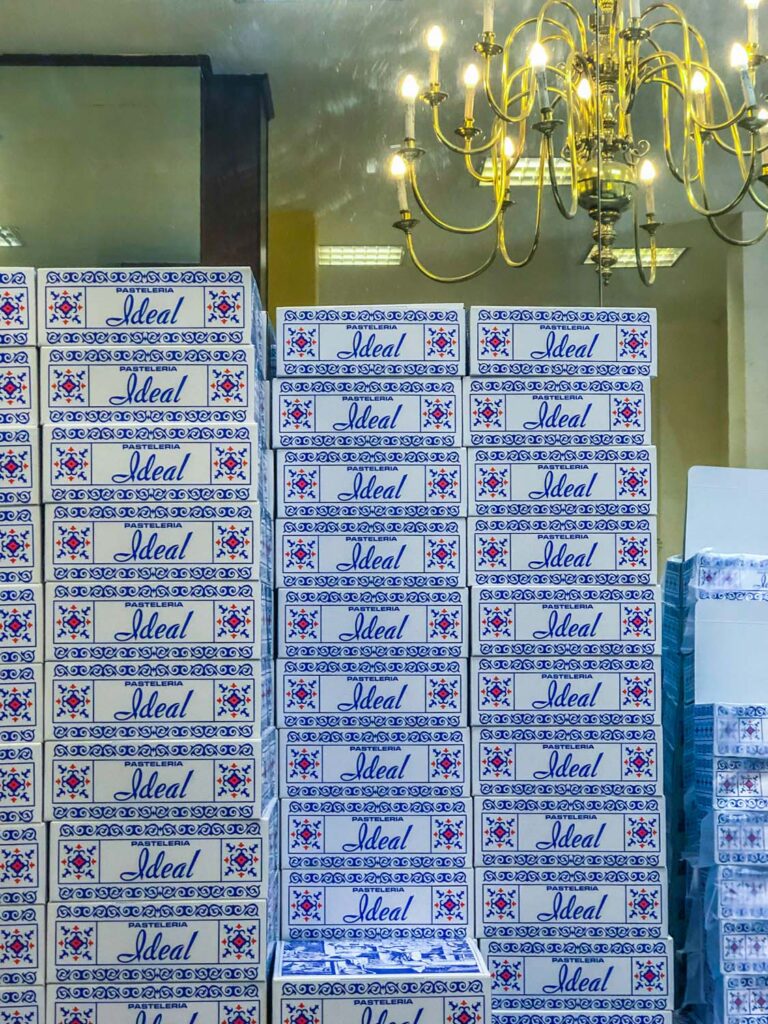
This bakery has everything from traditional Mexican bread and pastries, cakes and cookies to Parisian puff pastry, viennoiseries, and more! All of this is served up on huge platters towering with treats. Just grab a try and use the tongs provided to serve yourself up some pastries. Once you’re done piling up (they make great breakfast pastries, too), take your collection to the counter. There they will pack them up for you and give you a ticket to pay. After you’ve paid, they’ll deliver you your baked good, all perfectly wrapped up to go.
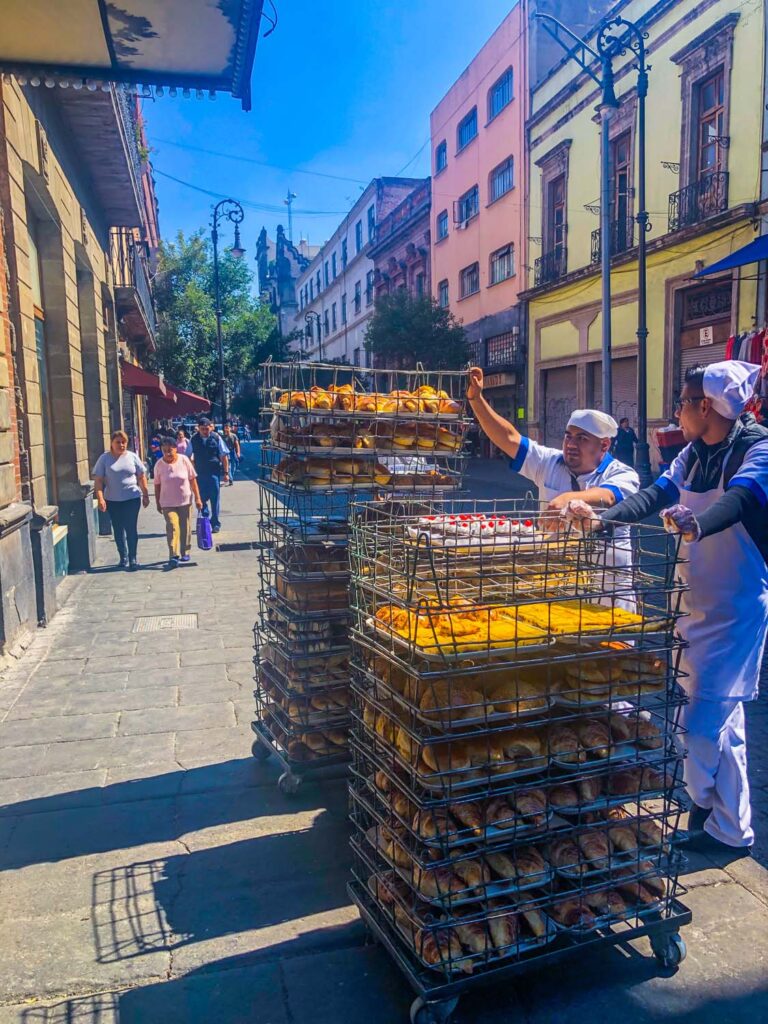


Torre Latinoamericana
At the end of Madero street is the great Torre Latinoamericana. This enormous skyscraper looks down over the Historic Center like its great protector. While the skyscraper might seem pretty modern for a stop on the “Historical” neighbourhood tour, the view you get from the top is really what makes visiting this place worthwhile. The Torre Latinoamericana stretches 166 meters (545 ft) up to the sky. The building was designed by some of the countries best engineers to ensure it could withstand the seismic activity that is prevalent in the area. It stood the test of time in 1985 when the building withstood the 8.1 magnitude earthquake that brought such immense damage to the rest of the Historic District.
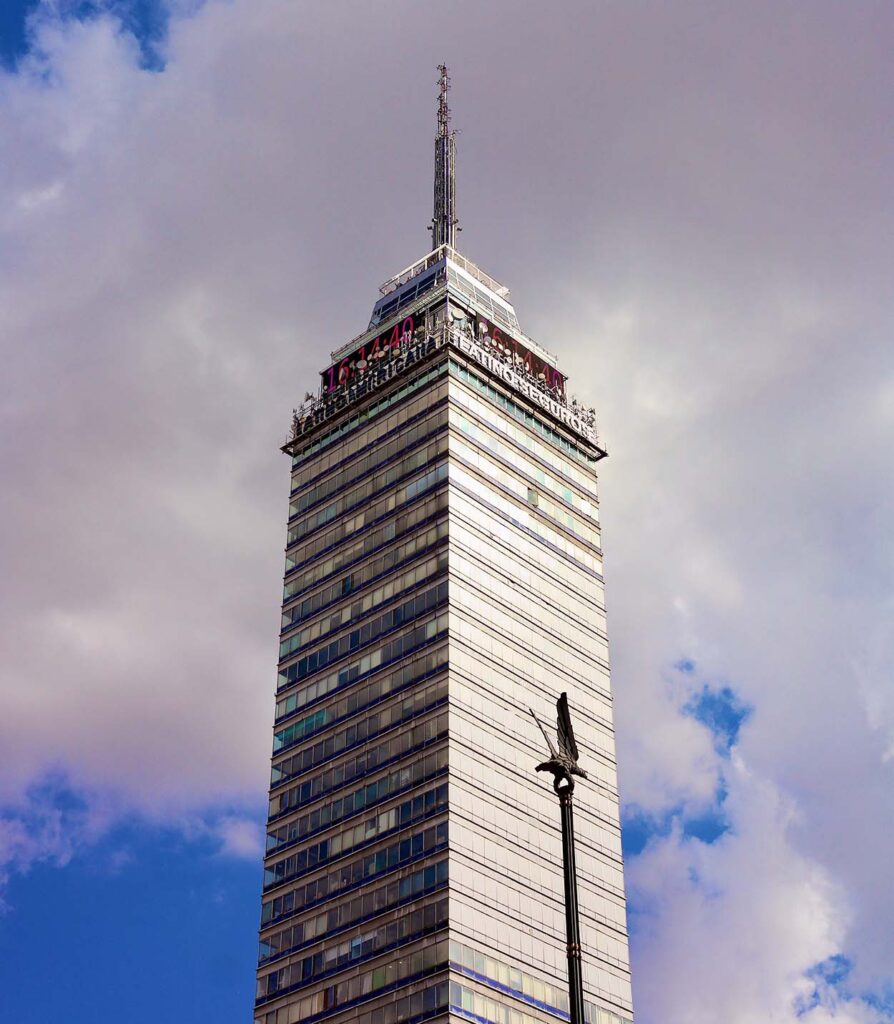
The building opened to the public in 1956 as Mexico’s tallest building and remained as such until 1982. Back then, skyscrapers were really architectural miracles. The other historic buildings in the neighbourhood were immediately looked over by locals and visitors in favour of the steel and glass tower. Today, it almost feels like the opposite. Most of us live in steel forests and are clamouring to see more of the baroque stone structure of the past.
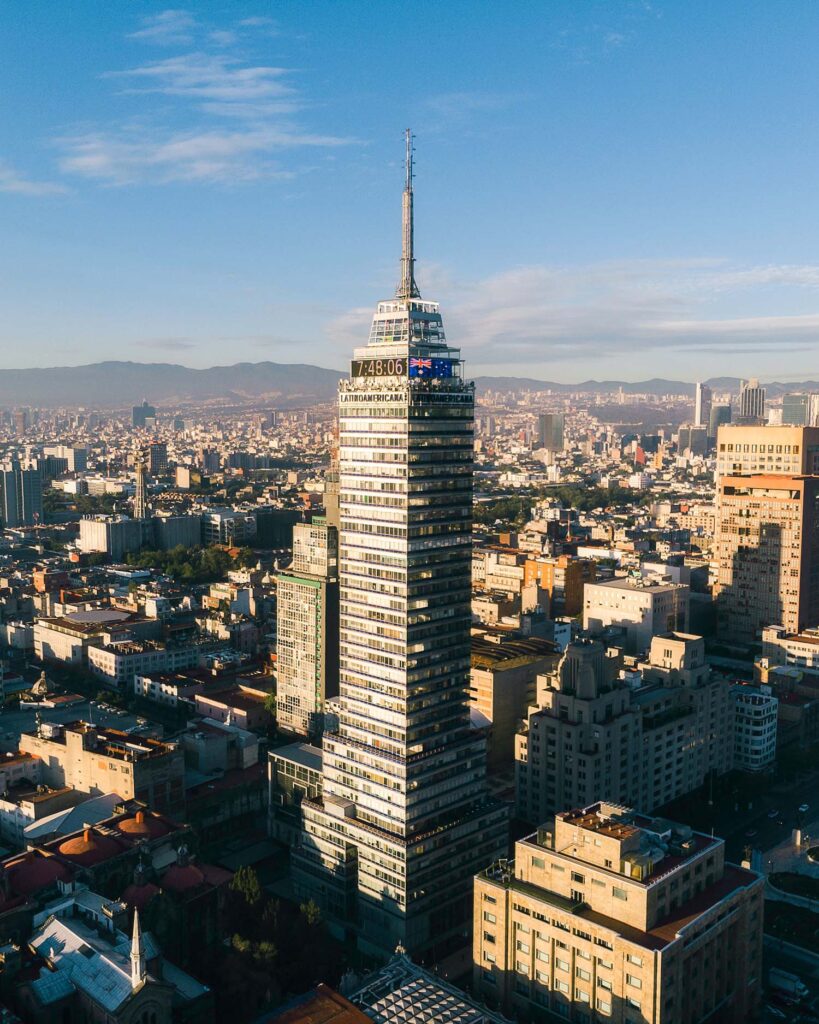
Observation Deck
You have the option to travel up the tower to experience the fantastic views all across Mexico City. The building’s 44th floor is home to a large open-air observation deck. On a clear day, you can see all across the city and even over to the snow-capped volcanoes of Iztaccíhuatl and Popocatépetl. From up above, you can really see how Mexico City is indeed located in a valley. Ticket to go up the tower cost 150 pesos (7 USD) per person.
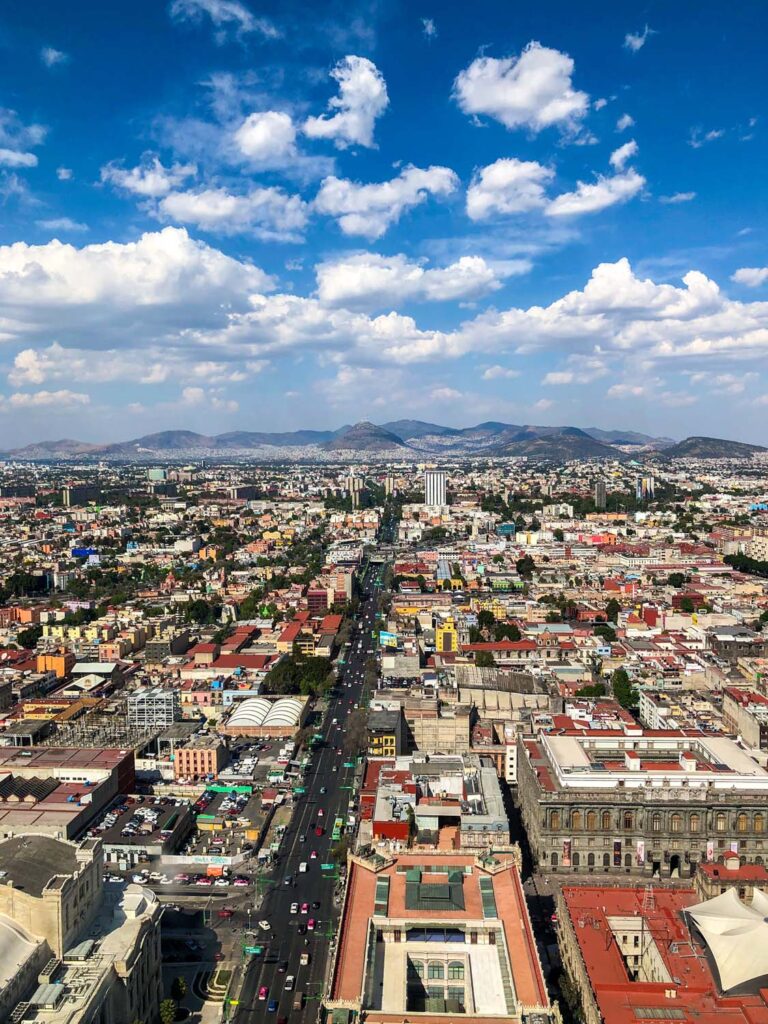
Avenue Francisco I. Madero
Exit the tower and take a walk along the main pedestrian street Avenue Francisco I. Madero. While today the street is very touristy with many international chains dotting the shop fronts, there are still many historical buildings to see along the way. You just need to know where to look. The street is named after the great Francisco Ignacio Madero González. Madero was a Mexican revolutionary, writer, statesman and the 37th president of Mexico. Sadly, Madera was assassinated in 1913, only two years into his Presidency.
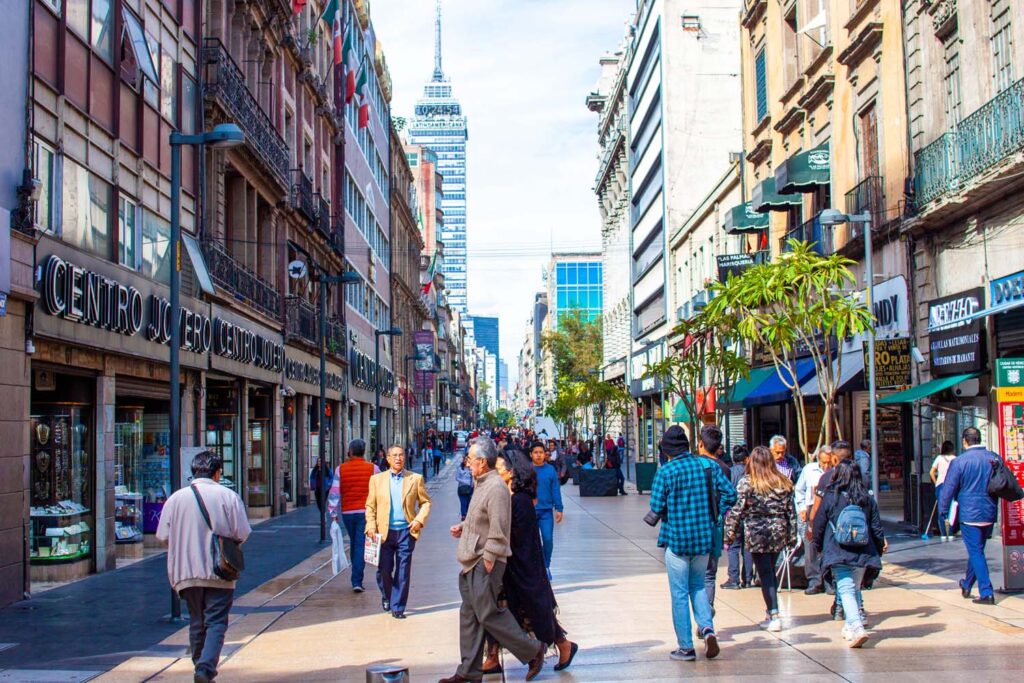
Casa de Los Azulejos
On the corner of Avenue Francisco I. Madero and Condesa, you’ll immediately be drawn to the blue and white tiles of the Casa de Los Azulejos or The House of Tiles. Madero Street was once the most highly sought-after real estate in Mexico City. The original residence was built for the wealthy Count of the Valle de Orizaba in the 16th century.
But the now-iconic colourful tiles weren’t added until 1737. After the Count’s death, the Countess decided to return from her home in Puebla to the capital city. Wanting to feel at home, she brought a large amount of the famous Puebla Talavera tiles with her. Puebla tiles were each handmade, and the sheer number of tiles on the facade was a way of showing off the family’s immense wealth, even after the Count’s death. It was a means of showing that Countess was still a power player and didn’t need her husband to run the show.
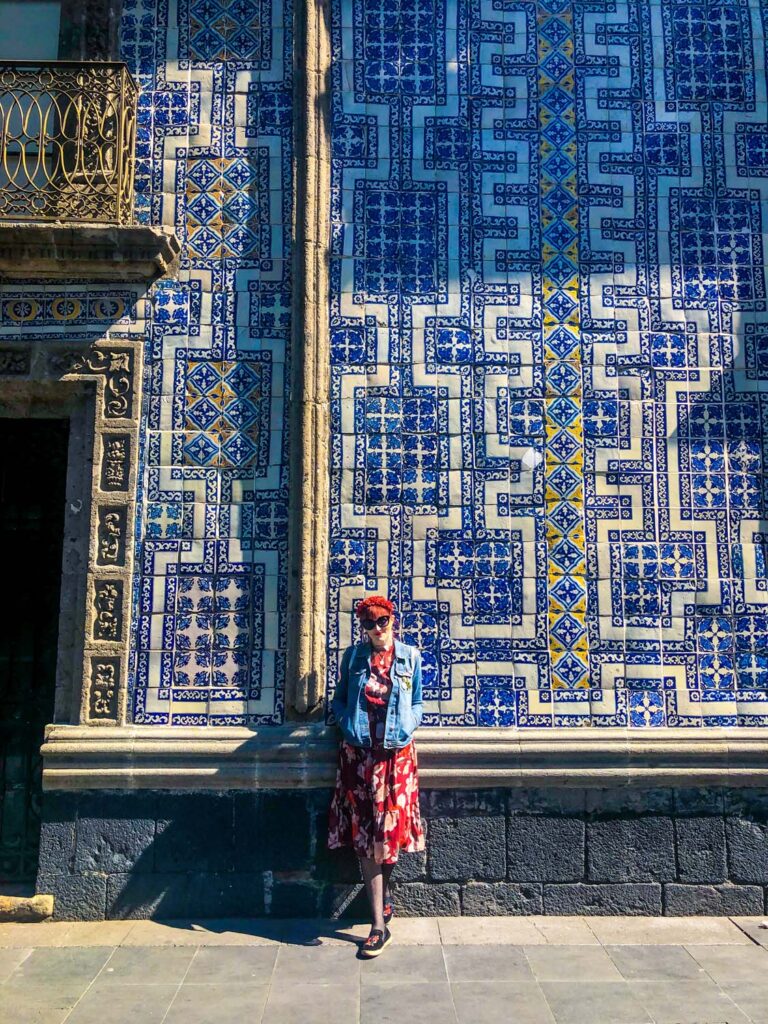
Talavera Tile
Talavera was a craft brought to Mexico by the Spanish. The Spanish established their workshop in Puebla in the 16th century. They chose Puebla as their industrial hub as it was an excellent location to nearby clay mines used to create the tiles. The colourful tiles were a popular feature inside monasteries and churches. Usually, only the most wealthy homes could afford to decorate their houses with them. While some Puebla tiles were painted with images of animals, birds and flowers, the most common variety contained simple geometric patterns.
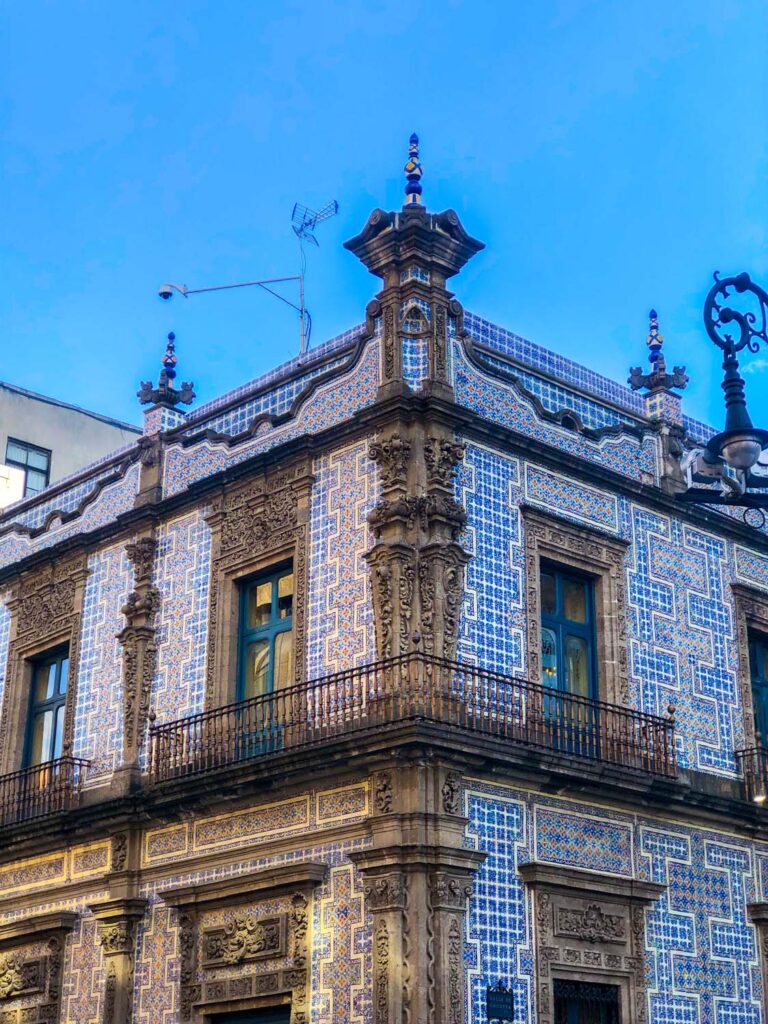

Sanborns
Florid stone carvings decorated the windows, doorways and balconies around the rest of the building. Carved into the stones are French porcelain crowns to denote the status of the house as a royal of the residence. The Count’s family eventually sold off the property in the 20th century. It was purchased by Frank Sanborn and his brother Walter. It was there that they would open their first soda fountain shop and drugstore. They named it the ‘Sanborns American Pharmacy‘ and it opened in 1917. Sanborns transformed the residential interior open-air courtyard into a restaurant with a large stained-glass roof overhead. The customer could dine inside the inner courtyard and enjoy the gorgeous antique murals that cover the walls, remnants of the 17th century home.
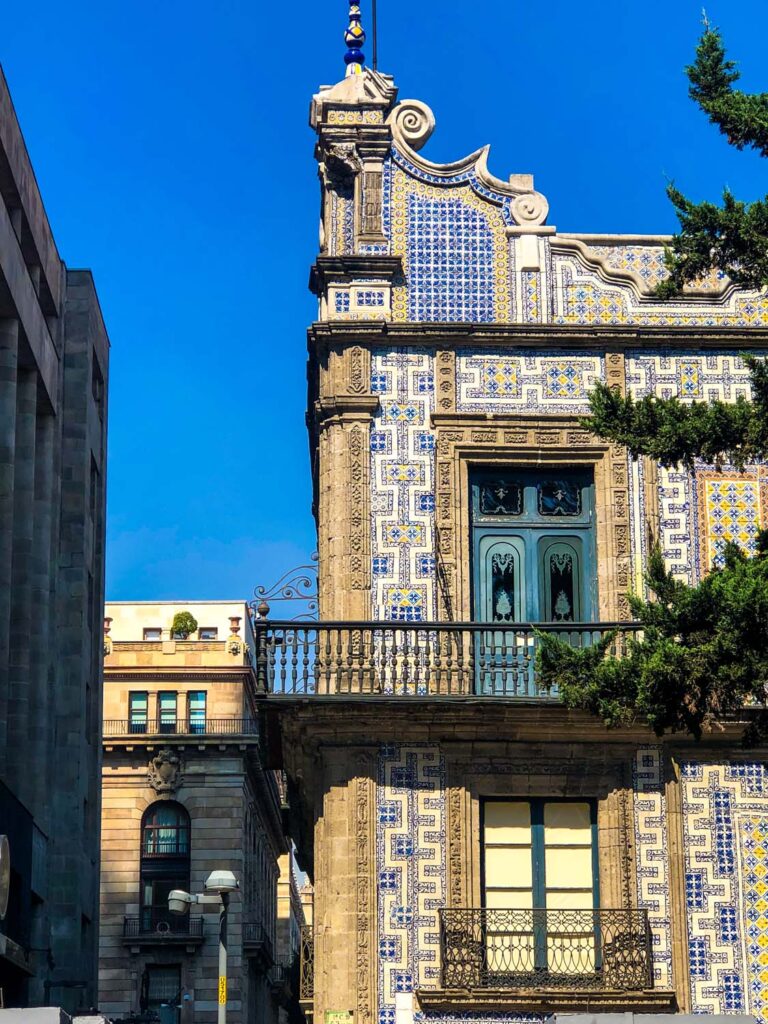
One of the best places to get a great photo-op is along the tiled exterior is on Condesa Street. This less busy side street has tiles that stretch along the entire passage and provide an unobstructed view of the building. The food inside the restaurant isn’t anything to write home about but it is definitely worth going inside to take a look at the interior courtyard. Sanborn’s is still a small shop, so you can also go inside to buy yourself a little souvenir or bottle of water to give yourself an excuse to tour the interior.
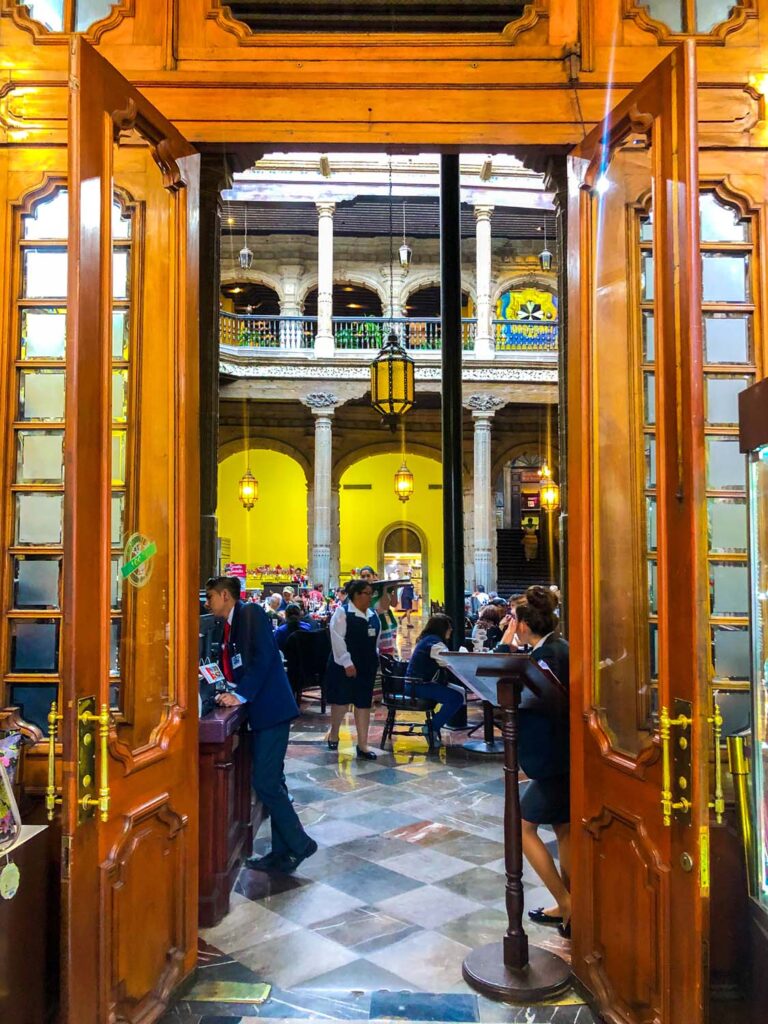

Church of San Francisco
Further along the street, on your left, is the large stone archway and steps leading down into the Church of San Francisco. The Church of San Francisco or the Iglesia de San Francisco was the original headquarters of the Franciscan friars. When Cortez first came to Mexico City, this spot was where he found Moctezuma II’s royal zoo. After the colonization, the zoo destroyed and the land used to build the largest and most influential monasteries in Mexico City. Initially, the church and its monasteries spread out over 32,224 square meters! This would have taken up almost the entirety of the city block around the area.
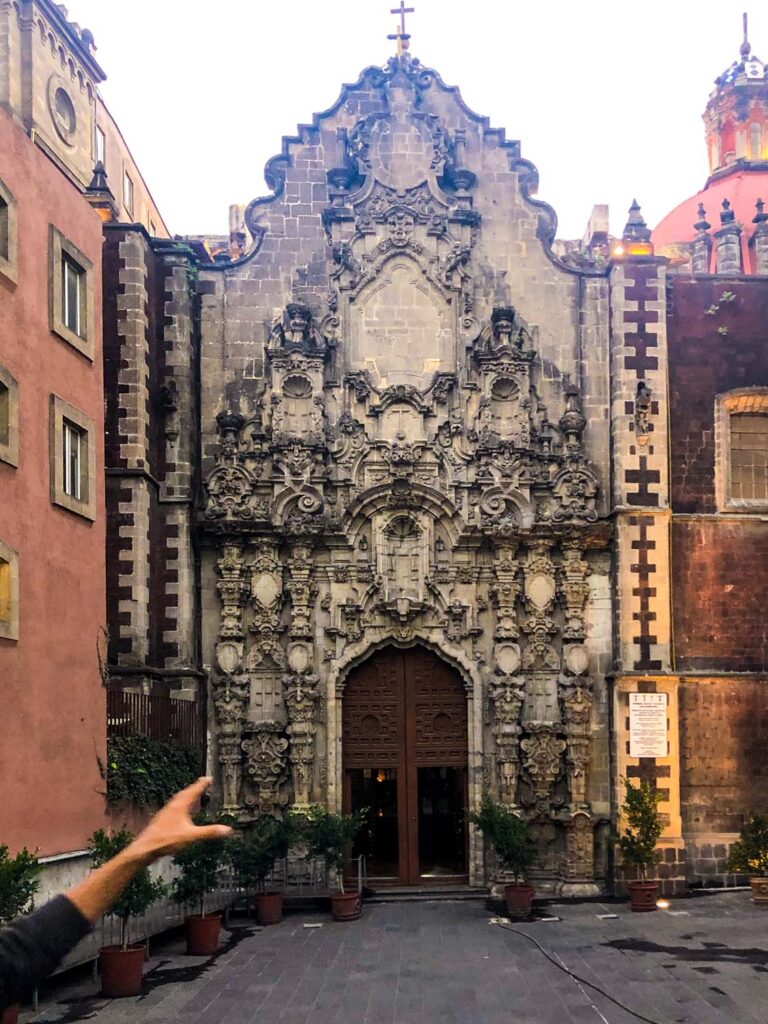
Balvanera Chapel
Today, the only remnant of the original complex is this small church built in 1710. The reason for the steps down into the church is because, like the rest of Mexico City, the building is sinking. You can’t even walk in through the original entrance as that has been walled up. Today, the direct access to the church is through the Balvanera side Chapel. The chapel’s facade was given a facelift by Lorenzo Rodríguez, who also designed the front for the Metropolitan Cathedral’s Tabernacle.
Walking inside, the most impressive feature of the chapel is the sizeable gilded altarpiece dedicated to the Virgin of Guadalupe. Her faded image is placed in the center of the golden altar. Walking up a few steps into the central part of the church, you are greeted by another great gilded altarpiece. A few of the little elements inside that I love are the stained glass windows with the red cross in the center. Although they aren’t highly sophisticated, I love the very stark imagery of that repetitive red cross illuminating the clerestory.
While the chapel walls are relatively plain, hung to decorate the large expanses of stone are these vast paintings. These paintings depict scenes from the life of San Francisco de Assísi, for whom the church and the Franciscan order are named. Each one of the paintings highlights one of Saint Francisco’s greatest virtues. See if you can spot them all.
Palacio de Iturbide
Head back down to Madera street until you reach the Palacio de Iturbide, just before the Calle de Filomeno Mata. Surrounded on either side by modern buildings, this ancient structure really stands out. The Palace was built in 1779 as a wedding gift from Count of San Mateo Valparaíso to his daughter. Apparently, the Count was worried his daughter’s new husband was going to squander his daughter’s dowry. So instead, the Count built the house using the entirety of the dowry to ensure the new husband wouldn’t be able to lose it.
Agustín de Iturbide, the Mexican army general and politician, lived here during the Mexican War of Independence from Spain. And it was actually inside the Palace where he accepted the crown of the First Mexican Empire. Because of this seminal moment, the building earned the nickname the “Palace of Iturbide“. The building is made out of that iconically Mexican tezontle and cantera stone. The facade was designed in a high gothic style featuring organic and geometric motifs such as flowers, vines, leaves, and even a mermaid. On either side of the entrance are two graceful male figures that look almost as though they are holding up the balcony above.
Taquería Tlaquepaque
If you’re looking for a cheaper alternative for lunch, make a quick detour over to Taquería Tlaquepaque. Taquería Tlaquepaque is your best budget option. This street taco establishment serves up plenty of options. But the very best one, in my opinion, is the tacos Al Pastor served with onions and pineapples atop a pile of roasted pork. Such a perfect sweet and salty combination.
Dulcería de Celaya
Make a quick stop up the street at Dulcería de Celaya where you can grab yourself some delicious Mexican candies. Dulcería de Celaya is a tiny, old shop selling traditional Mexican candies and sweets since 1874. Walking into the shop, it feels like nothing has changed in over 100 years. When the family-run shop first started selling candy, it was made in a small, improvised factory using wooden shovels, copper saucepans and a minature oven. They could only produce so much per day, often only one tray of candy. But the sweets were so popular that they would sell out day after day. As the demand rose, they managed to expand their production to meet the needs of the city.
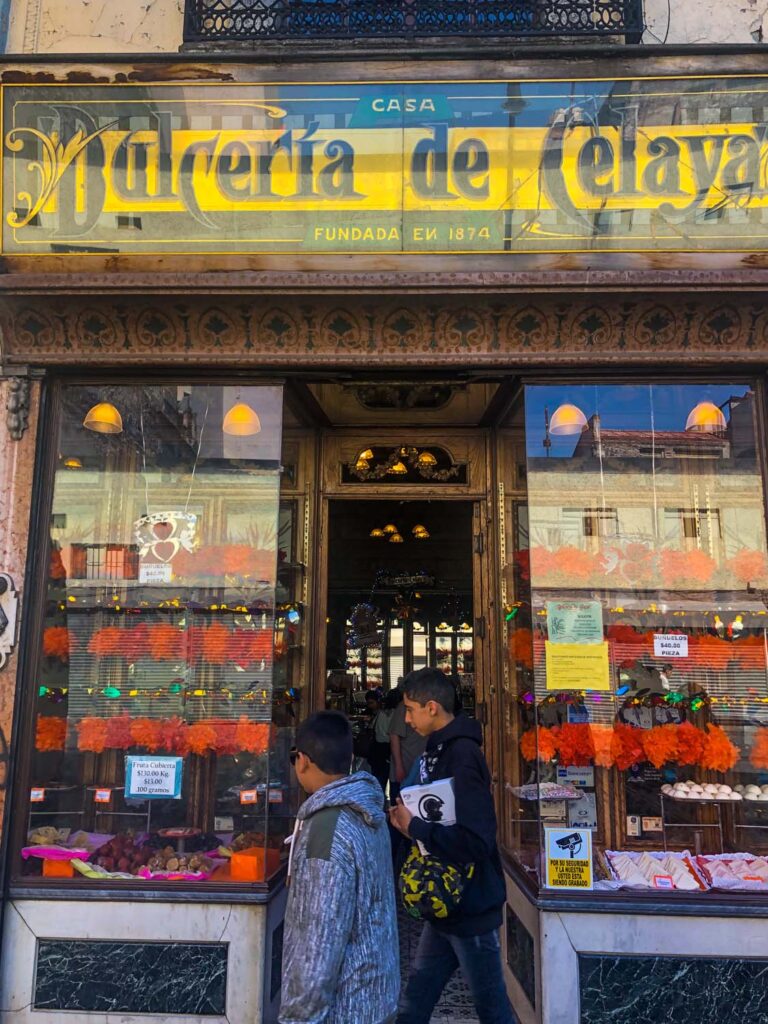
Even today, they produce candy in much the same way as it was made in the beginning, still out of that tiny kitchen. When you walk in the doors, the smell of fresh pineapples, strawberries, guavas and coconut fills the air. It’s intoxicating. The candy is very well priced, so even if you don’t’ recognize anything, just let the smells guide you and try whatever your eye is drawn to.
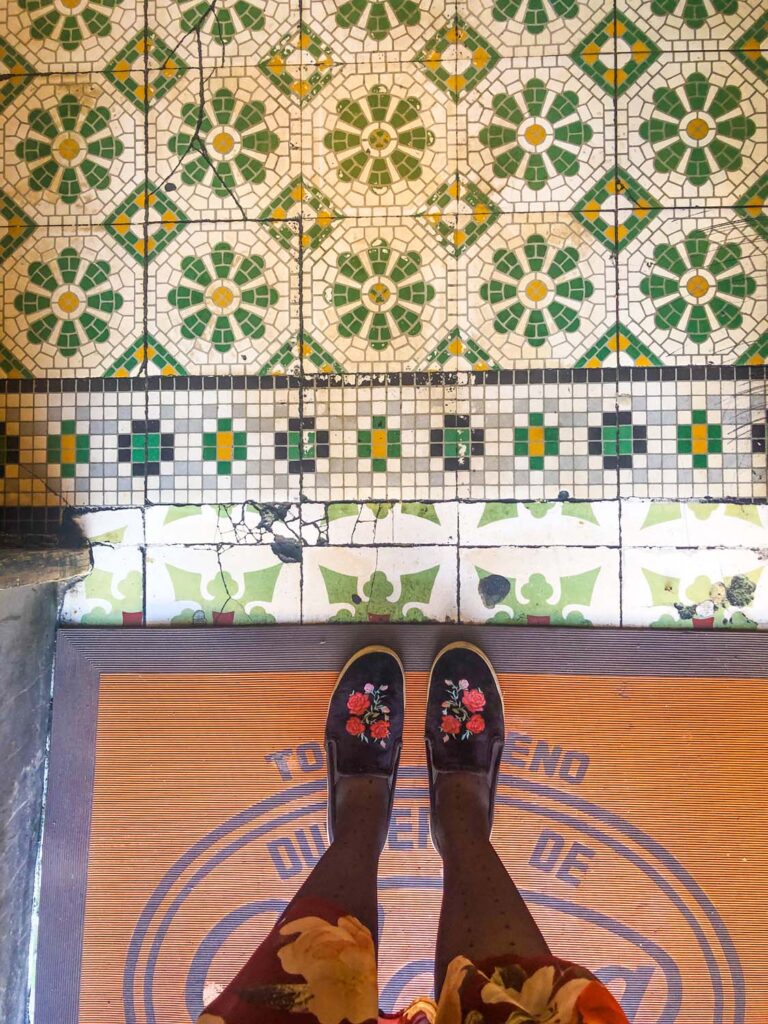
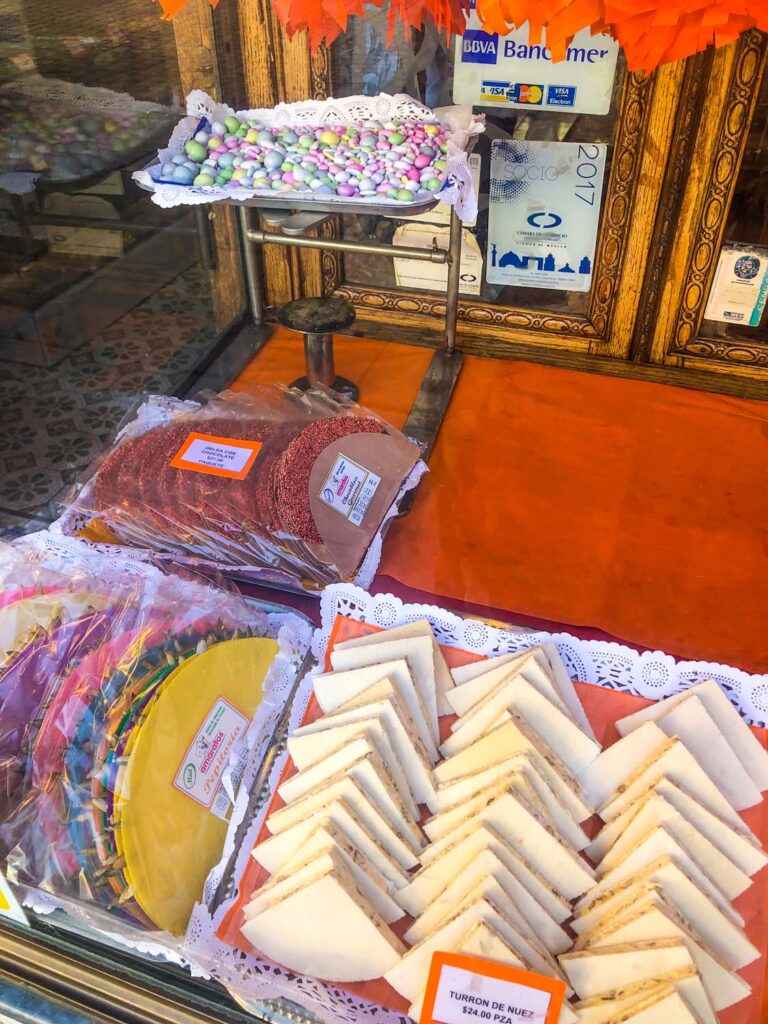
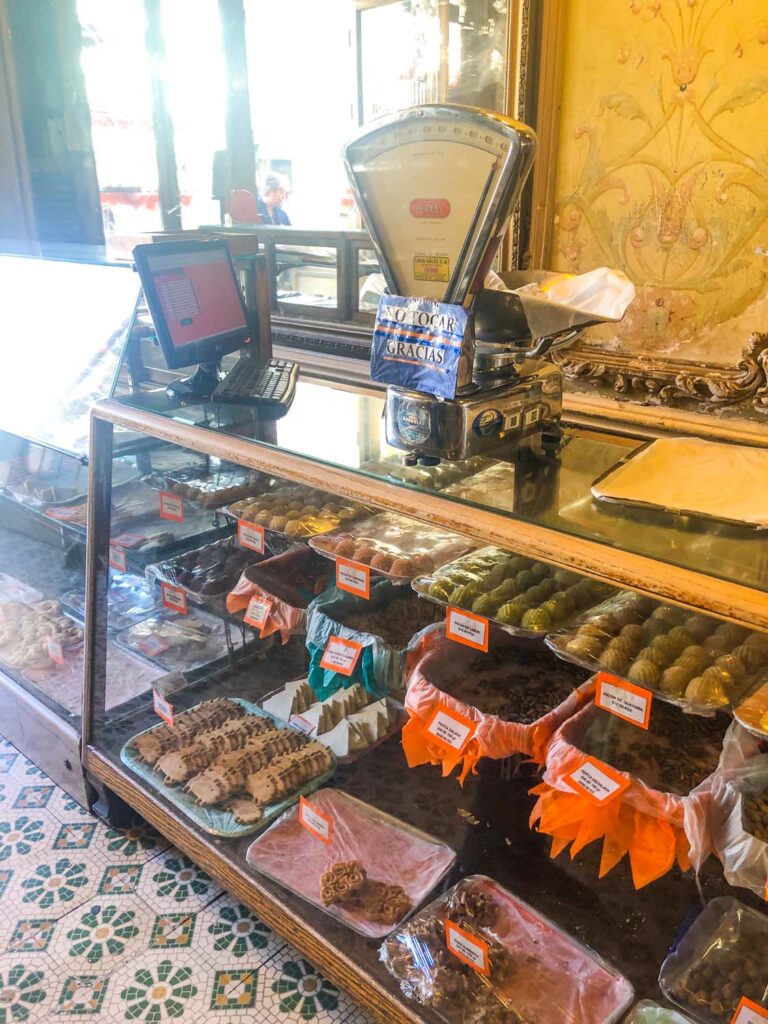
Mexico City Cathedral Metropolitan
The crowning glory of the Historic Center of Mexico City is the enormous Cathedral of the Assumption of the Most Blessed Virgin Mary into Heavens. The stone monument dominates the border of the huge Plaza del Zócalo. While its full name is “Cathedral of the Assumption of the Most Blessed Virgin Mary into Heavens,” it also goes by the much shorter nickname “Metropolitan Cathedral” or “Mexico City Cathedral.” The enormous church has stood here for over 400 years, being constructed from the literal bones (or stones) of the Templo Mayor.
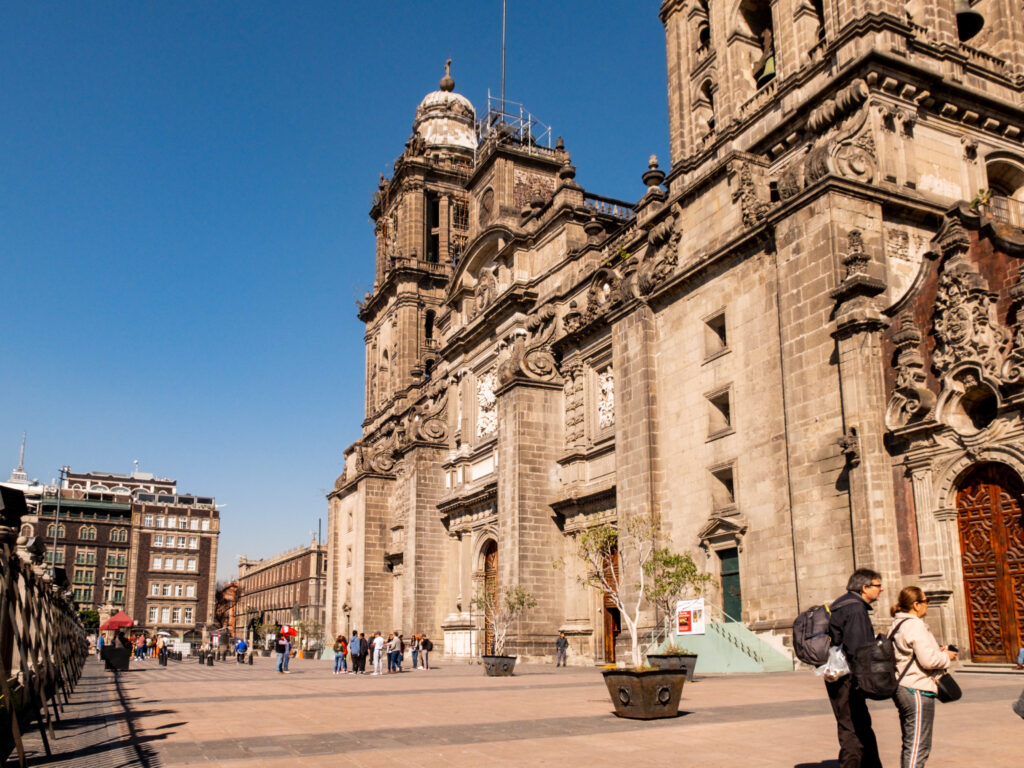
The towering ornate church is considered one of the masterpieces of Mexican architecture and is Latin America’s largest and oldest cathedral. If you’re visiting Mexico City, you absolutely need to make a stop inside! Explore the interiors and wonder at the amazing monuments, chapels, architecture and incredible atmosphere found inside the Mexico City Cathedral. I have an entire guided tour of the Cathedral to help you better understand all the different aspects of its history and architecture. It’s pretty in-depth since I truly think it is one of the most spectacular places to visit. But if churches aren’t your thing (which I totally get), you can just poke your head inside and head back out to the Zocalo.
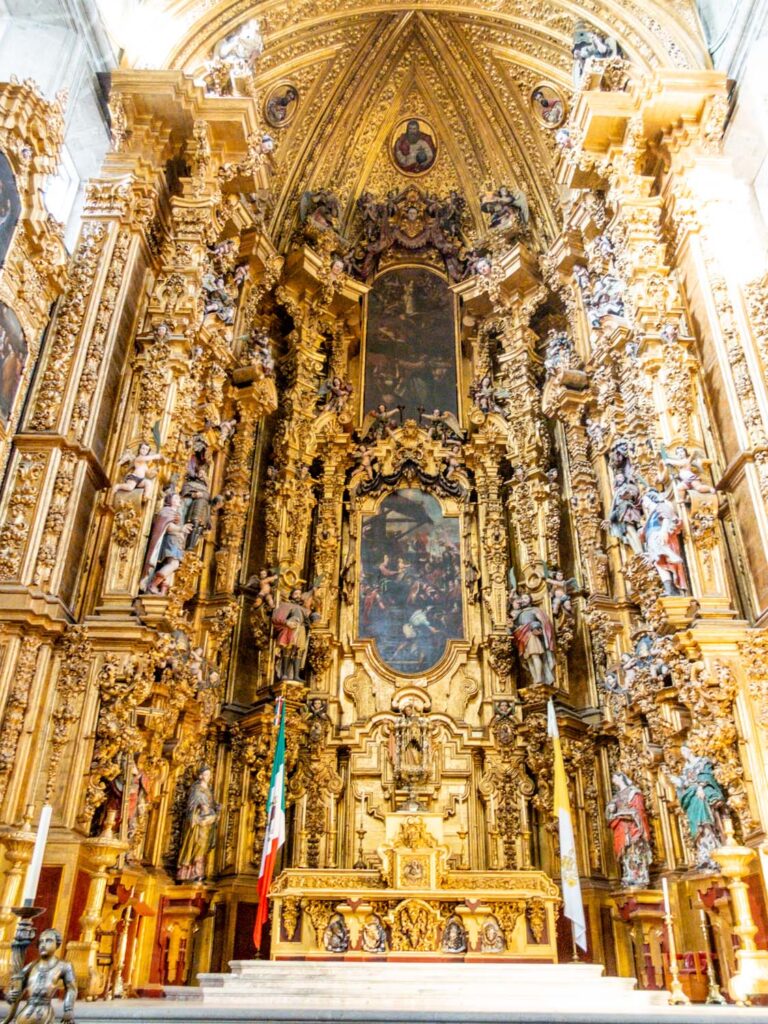

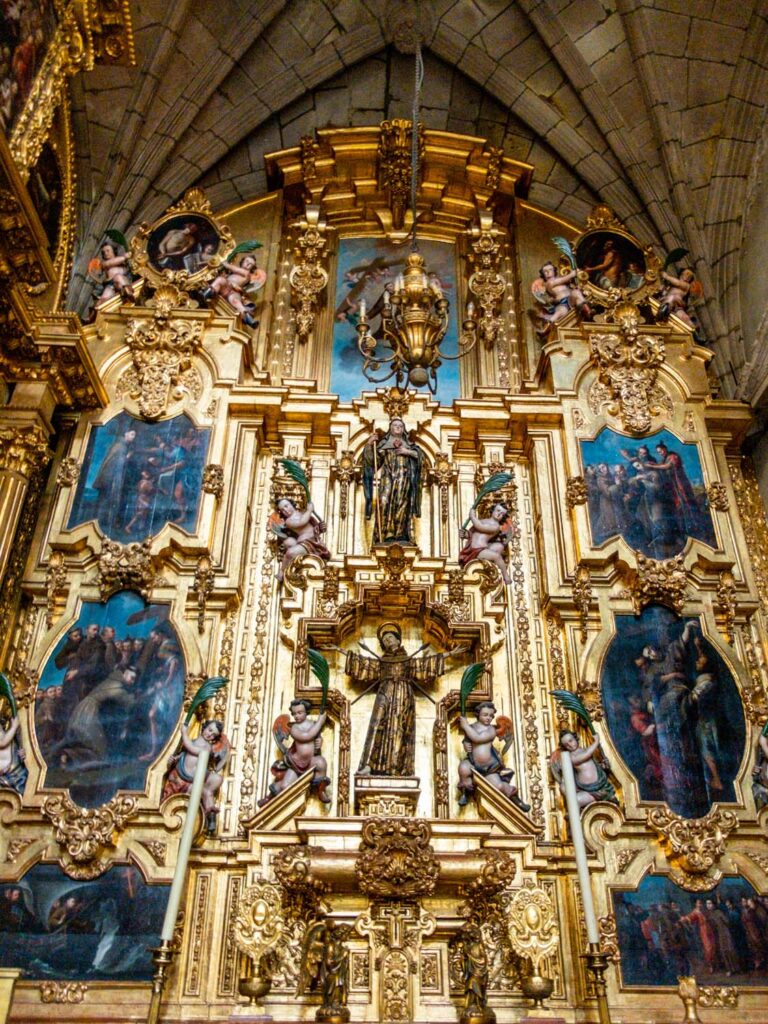
Templo Mayor Museum
Ancient Templo Mayor. Over the years, after many successful excavations and archeological digs, much of this historic site has been uncovered. It is now able to be viewed once more by the public inside the Templo Mayor Museum. The museum is definitely worth visiting as it displays some of the most significant treasures and relics of the great Aztec people. I would advise returning here on another day as a proper walk-through takes about 2-4 hours to explore. For our tour, the most exciting details of the ruins can be viewed from the street without going inside.
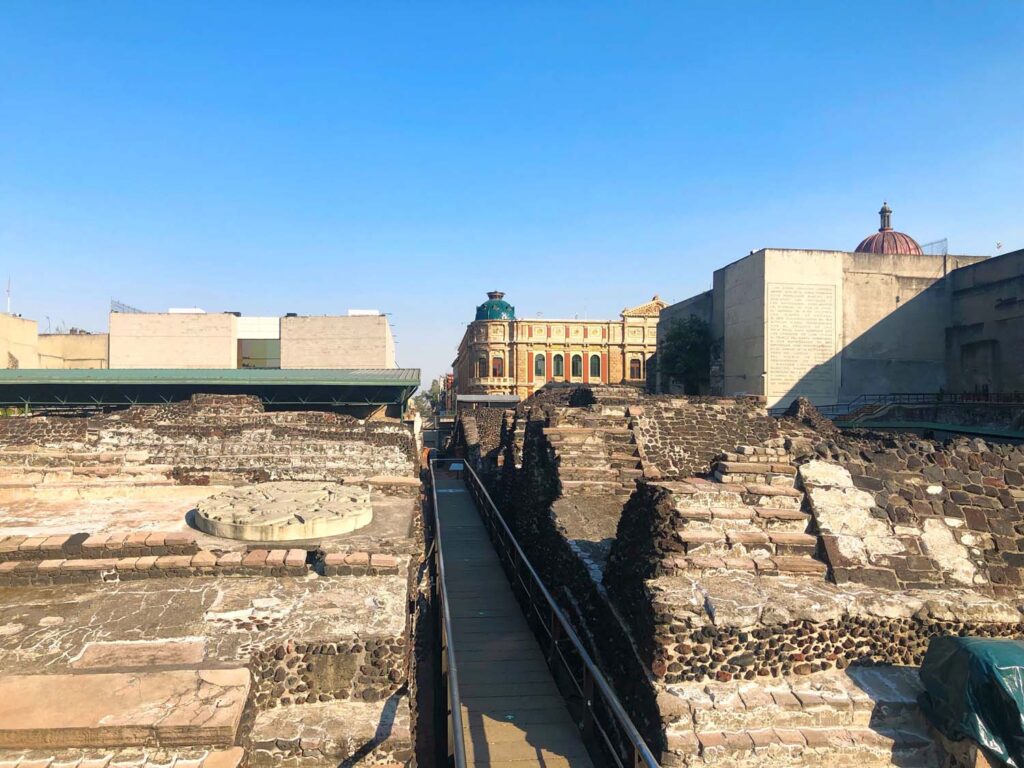
History of the Temple
The entire modern metropolis of Mexico City was built atop the ruins of the ancient Aztec city of Tenochtitlan. In the center of Tenochtitlan was the Templo Mayor, the city’s primary temple complex. The temple’s original name, in the native Nahuatl language, was Huēyi Teōcalli. According to legend, the temple was located where the god Huitzilopochtli gave the Mexican people the sign that they had reached the promised land. This sign was that iconic image of an eagle on a cactus with a snake in its mouth.
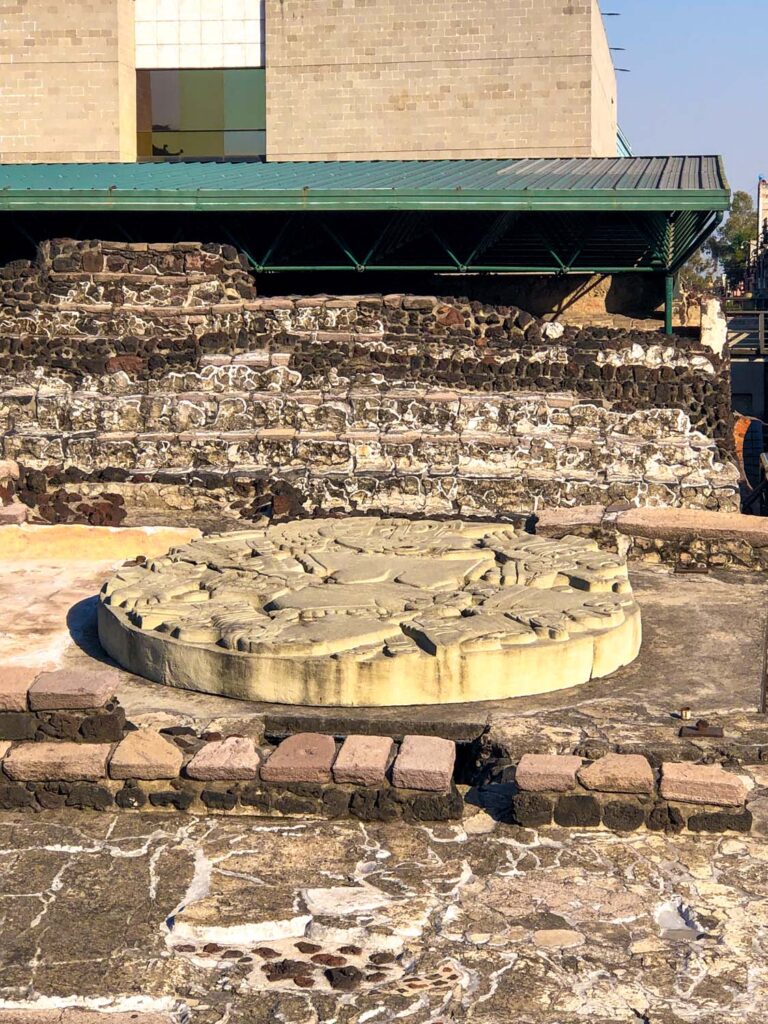
This great pyramidal temple was first built in 1325. Unlike Egyptian pyramids, which were primarily large tombs meant only for the Pharaohs, these pyramids were a big part of the life of the city. They were composed of four slopped terraces with secret passages inside. On the top of the pyramid was a flat platform where two temples were located. These were dedicated to Huitzilopochtli, god of war, and Tlaloc, god of rain and agriculture.
Inside the temple were the large idols of each god. They were made of amaranth seeds which was a traditional sculptural material in the pre-hispanic era. The seeds were stuck together with honey and even human blood to form the shape of the god. The blood was always given by willing human sacrifices as they wanted to donate a part of themselves to the god. These human sacrifices shocked Cortés when he first visited Tecnochiland. It was one of the events which added to his disdain of their beliefs and led him to think they were a “savage” culture.

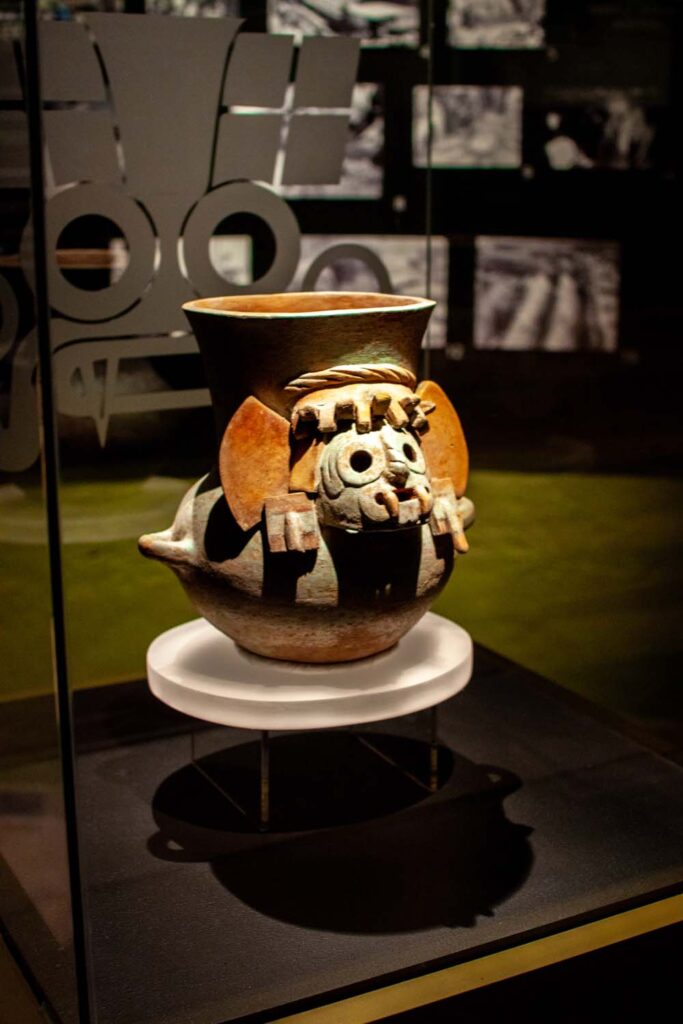
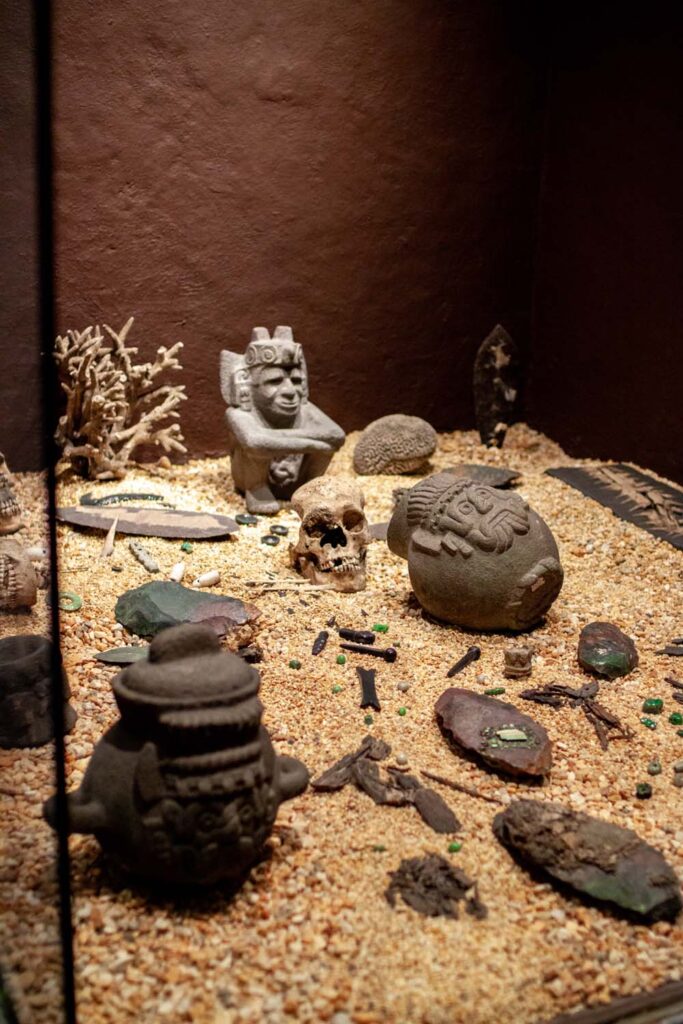
The Discovery of the Temple
In 1521, after the invasion of the Spanish, the temple and the rest of the Aztec buildings were destroyed. The Spanish used the site as a spot for their new Cathedral. Hundreds of years past and many people completely forgot about it until it was nothing more than legend. But in 1978, when an electric company was undertaking some excavation work in the area, they discovered these incredible ruins underground. Back then, 19th-century colonial buildings covered the plot of land under which the ruins were hiding. The government of the time thankfully saw the importance of the archaeological site to be of far greater significance than the colonial buildings. They were demolished, and a massive undertaking began, working to uncover the ruins and preserving the treasure found within.
The parts of the temple we can see today are elements of the base of the pyramid and the slope upon which the rest of the pyramid would have travelled. Large sculptures of the gods jut out from the base of the temple. Still to this day, even after being buried underground, you can make out the bright colours that they were painted with when they were first created. These Aztec towns were a rainbow-hued metropolis and a sight to see to be sure.
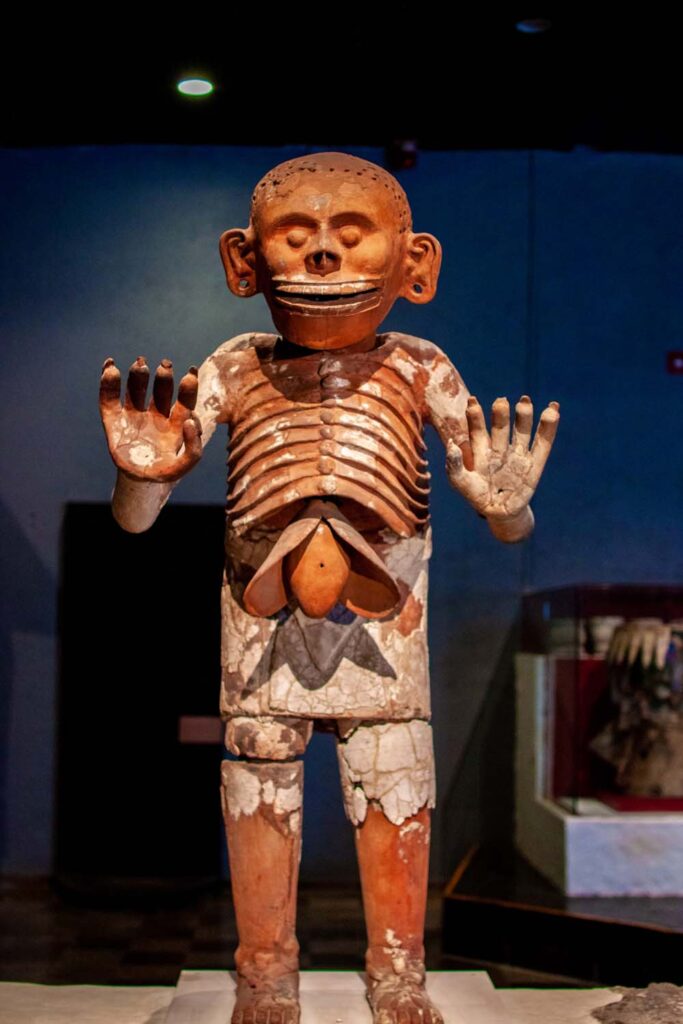
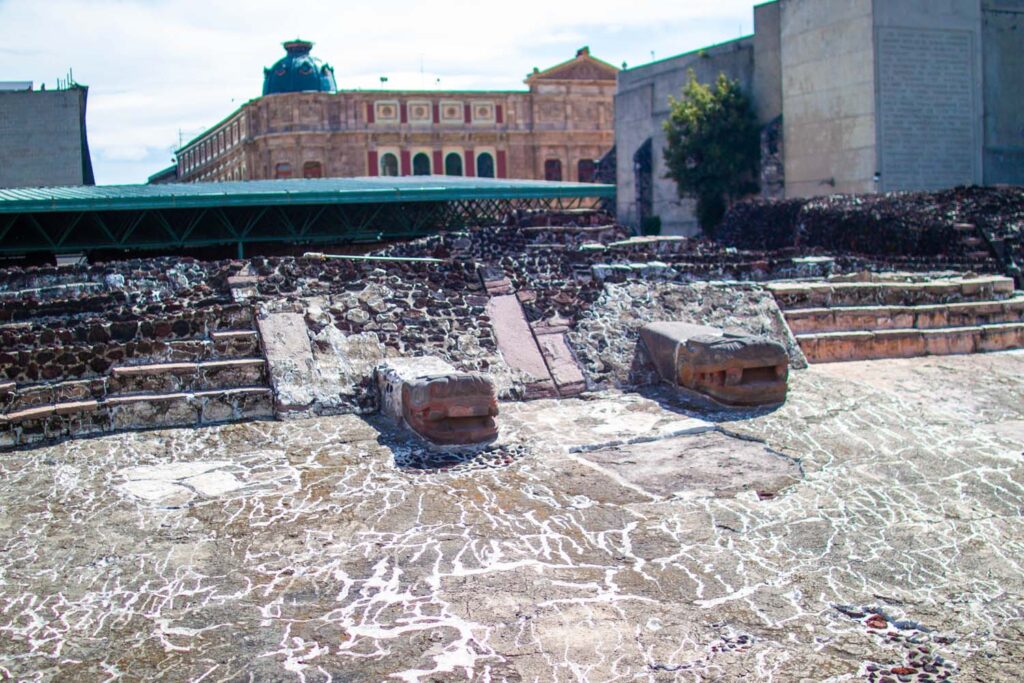
Palacio Nacional
To finish off our tour of Diego Rivera’s mural, a visit to the Palacio Nacional (National Palace) is in order. The Palacio Nacional is an enormous museum with so much to see and do. But for our purposes, we are just entering to see the courtyard murals. Once we arrive at the Zocalo, we will speak a little bit more about the grand facade but for the time being, let’s go inside to get a look at the courtyard.
Entrance to the National Palace is free, although there is usually a long lineup to get inside. You need to leave a piece of ID with the guards at the door. Since the Palace is still home to the offices of the Mexican President, security is critical. They need to control the number of people and keep track of exactly who is inside. Entrance to the National Palace can be found on Moneda Street.
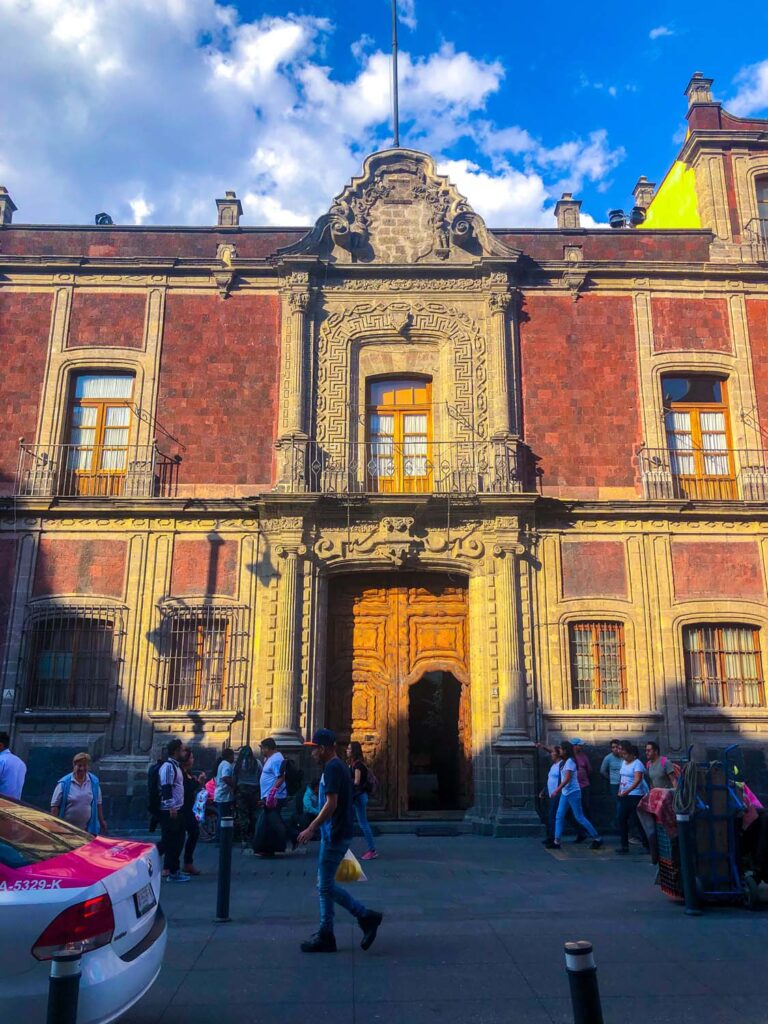
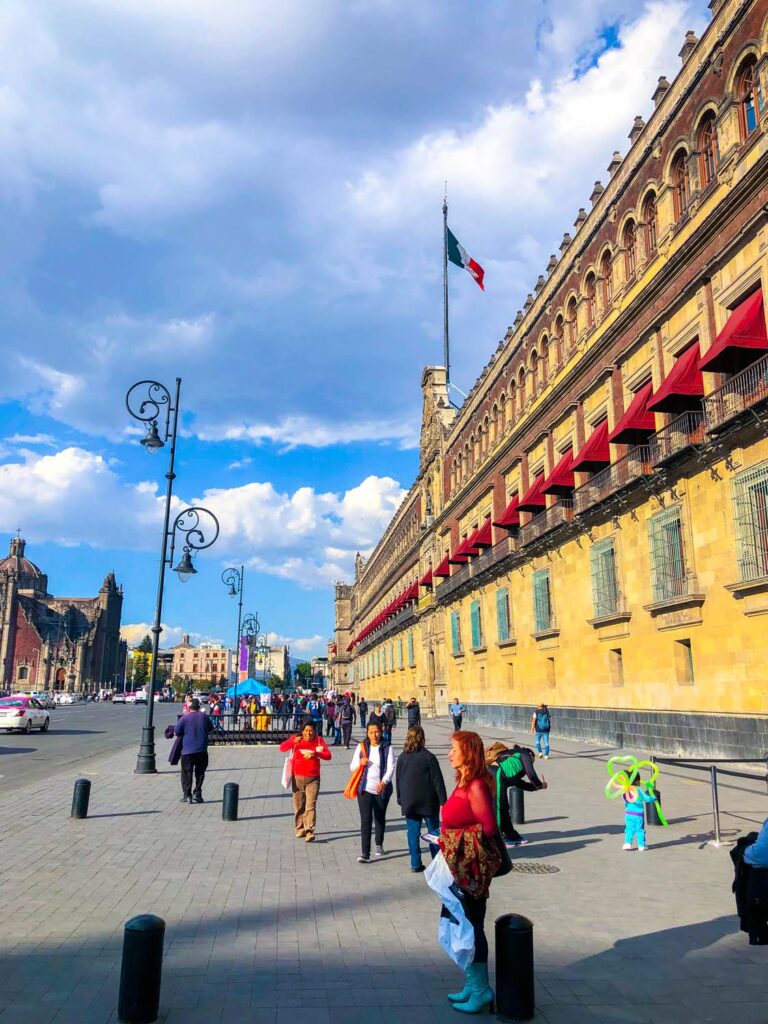
History of the Palace
The site of the building was once home to Moctezuma II’s Palace. His grand residence was built in 1521. When Cortés first visited the Palace, he described it as having a surprising array of riches. The walls were made of marble, and the facade contained a carved shield of Mexico’s iconic eagle with the snake in its claws. Inside, the building was very modern, with sanitary facilities, fountains, gardens, bedrooms with rich tapestries of rabbit fur and feathers. In addition to being a royal residence for the rulers of the Aztec city, it was also a meeting place for the elder tribe members. Here disputes and discussions would take place to ensure the wealth and happiness of their people.
Sadly, after the invasion by the Spanish, Cortés seized the residence from the Aztecs and used it as his own home. Passing it down to his son in later years. The Palace suffered a devastating fire in 1692 that destroyed much of the original structure. Many of the original stones that could be recovered were used in the reconstruction efforts. However, the design of the new Palace was a much different style. This one was styled in the Baroque fashion of the time. It seemed that over time, every generation added their own touch to the building. And now, it looks more like a patchwork quilt of the ages.
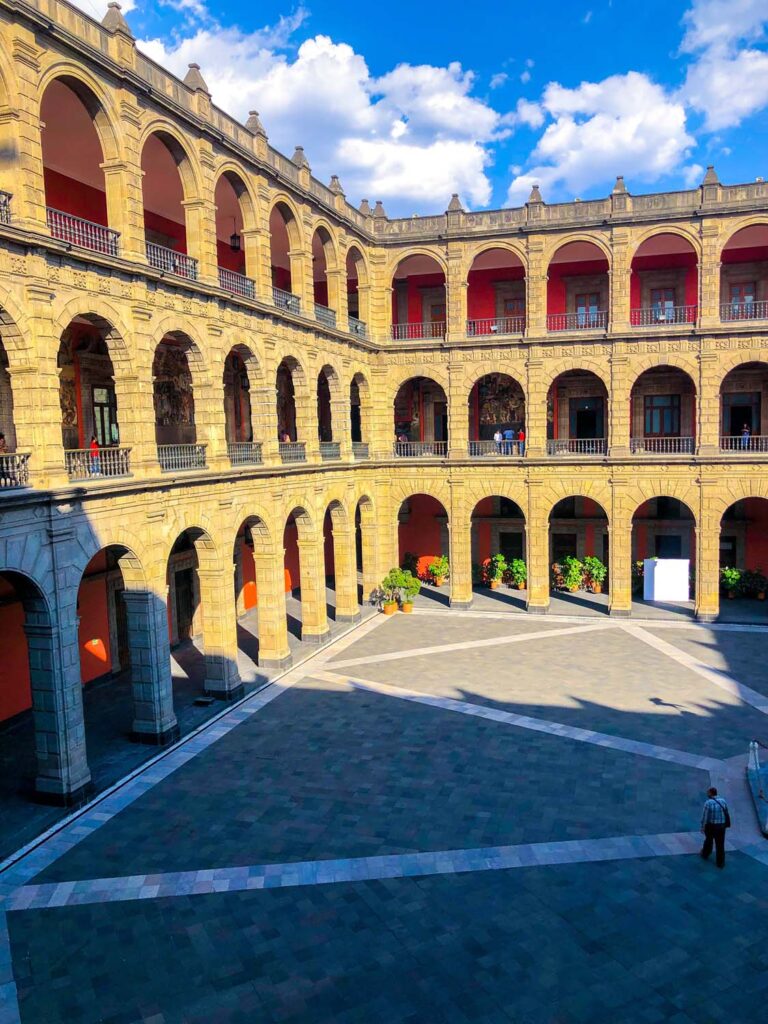
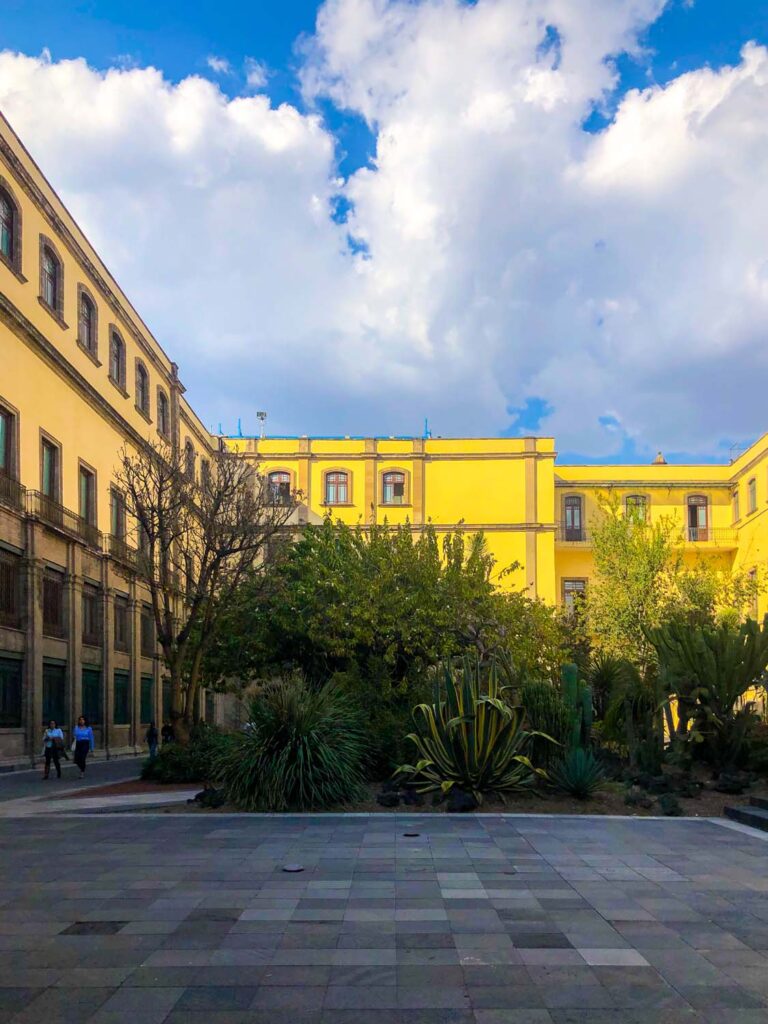
History of Mexico Mural
Walking inside the National Palace, follow the signs for the ‘History of Mexico Murals.’ These can be found within the great courtyard, surrounded by Baroque arches. Walk up to the main stairwell, where you’ll immediately be struck by this immense masterpiece. The mural depicts the history of Mexico from the dawn of human existence through to the 1920s. Rivera started work on this mural in 1929, many years after his first mural project. The precision and confidence in his technical skills and expressive style are evident in this work of art. Rivera was decisive in using his art to communicate his ideologies about communism and the decisive rejection of the colonizers. He wanted to bring the crimes of the part clearly into the people’s minds to ensure these atrocities were never forgotten.
The main message of the mural surrounds the indigenous Mexican people’s struggles to preserve their culture, National identity and country against the brutal colonizers. Standing at the base of the stairwell, take a minute to appreciate the sheer grandeur of the entire piece. So much of the story is a sad one—a classic tale of good vs. evil. The goodly indigenous Mexicans had one of the most vibrant cultures. Yet, they were practically wiped out by the evil, invading Europeans.
If you squint and look at the entire piece as a whole, the bright colours and expressive shapes look powerful, hopeful and strong, just like the Mexican people. Despite the horrors of the past, the post-revolution population believed in the future of their country. Especially as it became an independent nation. And that their strength and perseverance over the years was what would conquer evil and allow their great country to prosper.
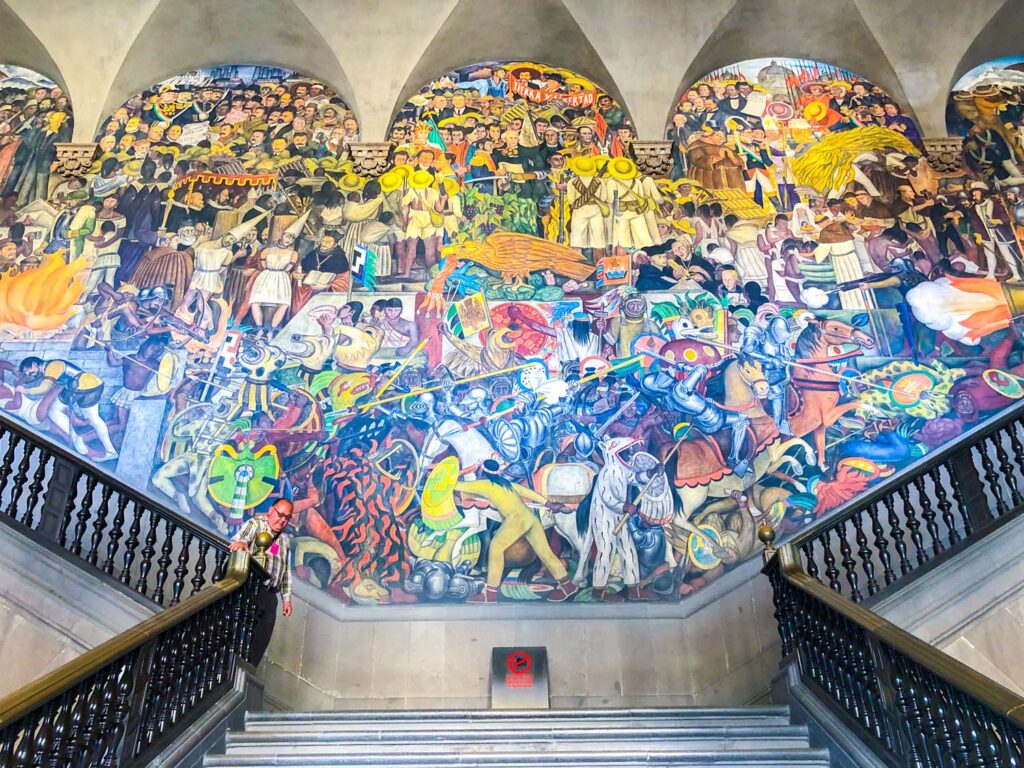
Aztec Hsitory
Walk up the stairs to the landing in the center, and look up at the left side, or North Wall. This part of the mural depicts the indigenous Mexican’s long before the arrival of the Spaniards. They are surrounded by the fantastical Mexican landscape all around them. The blue is almost heavenly above—the large bright sunshine above, casting all of them in celestial light. The Aztecs believed in the sun god, as can be seen in the all-seeing eyes painted onto the sun’s face. Just below the sun, you can also see an erupting volcano with Xiuhtecuhtli‘s “the Lord of Fire” exploding from the mouth of the volcano. In the sky flies Quetzalcoatl, the Feathered Serpent deity and god of the wind and the rain.
Lower Level Depictions
The lower part of the mural is riddled with images of Mexicans fighting against the heavily armoured calvary of the Spanish and French attackers. The beautiful and bright feathered costumes of the Aztec leaders, crushed and fallen under the feet of their enemies. Cortez himself can be seen in the middle of the painting. He is the only mounted soldier with his face exposed. The rest of the attacker’s helmets are closed. But Rivera paints Cortez with his helmet raised so his actions are not anonymous.
Cortez’s armies have modern weaponry making their defeat of the Aztecs a foregone conclusion. Despite them being outgunned and outnumbered, the Aztecs fought valiantly against the Spanish as seen on the right and let corners. All the while, the Aztecs are being watched over by a great golden eagle in the center. The eagle sits perched atop a cactus with a serpent in its mouth. The design of this symbol is rooted in the legend that the Aztec people would build their great city in the spot where they found an eagle eating a snake on top of a cactus. They called that place Tenochtitlan (Mexico City), and to them, it was worth fighting for.
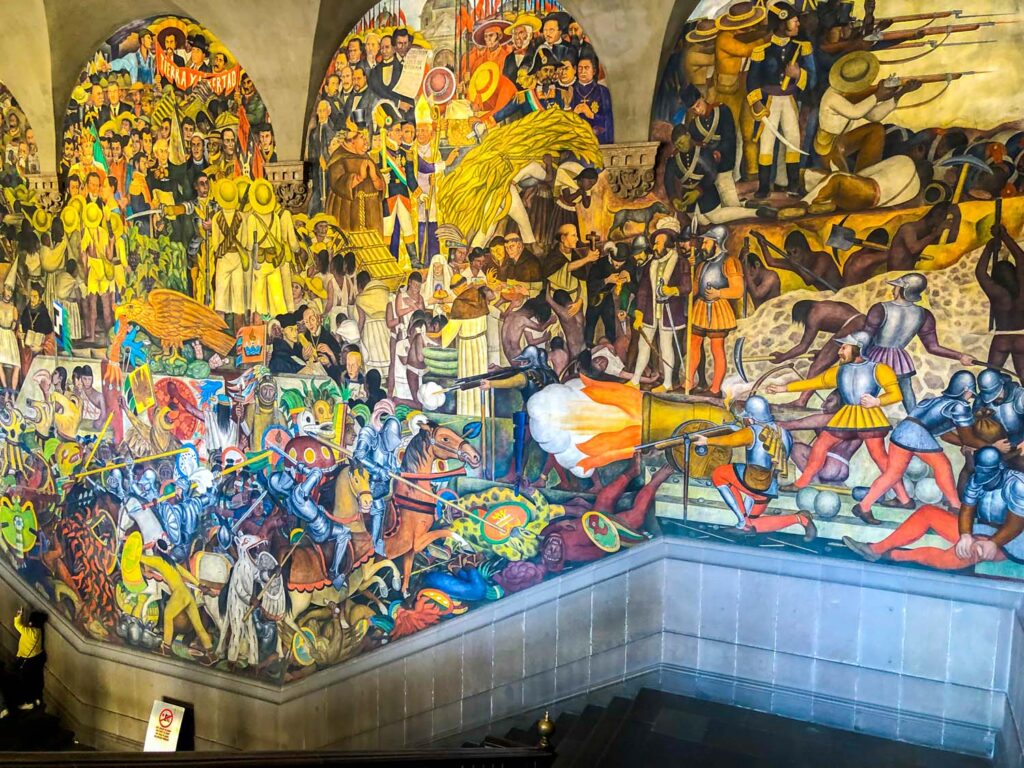
South Wall
The south wall to the left of the main stairwell depicts the future of the Mexican people. The imagery represents the ideals of progress, prosperity and hope for a better future. At the top of the mural is the image of Karl Marx holding his great Communist Manifesto on a large scroll. To the right of this is a man flying the Soviet flag. When the mural was painted, the Mexican people and Rivera himself had solid socialist tendencies and the Soviet flag can be seen throughout imagery from this era.
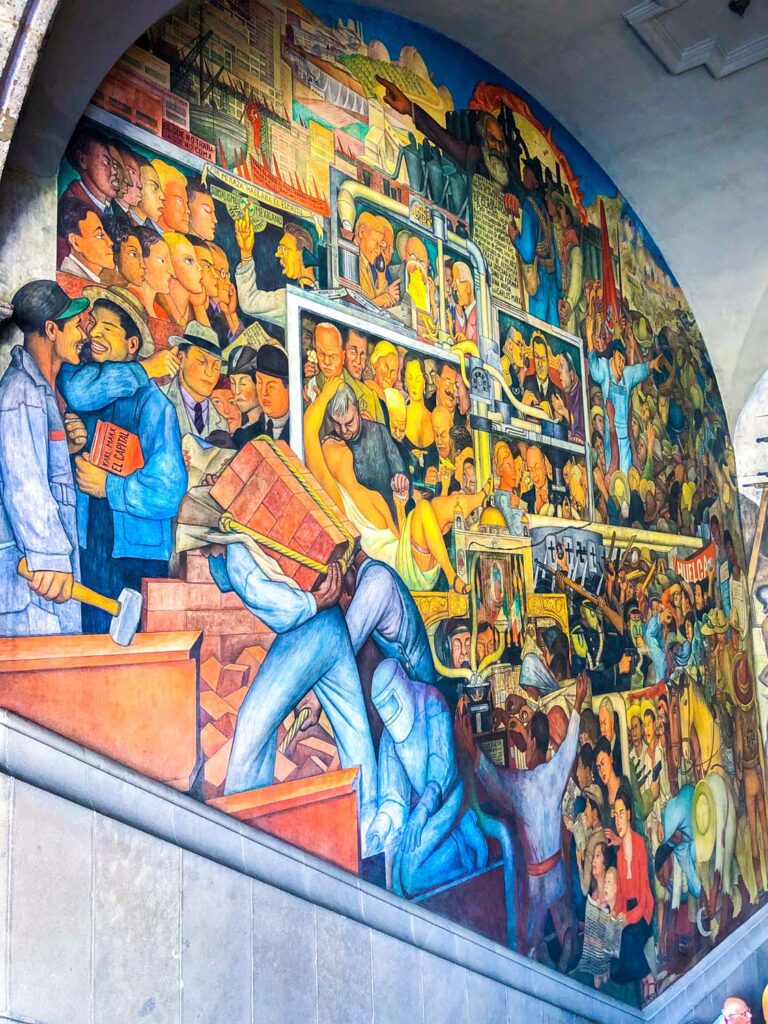
To the right of Karl is a scene of Mexican workers. They are being attacked and oppressed by a group of police wearing large gas masks. This scene takes place in front of the silhouette of Mexico City’s skyline. While the other two murals are more fluid in their collage-like design, this mural is framed in harsh geometric, metal beams. Inside these almost cage-looking rectangles are pictorial representations of what Rivera saw as negatives social forces in high society.
At the bottom of the painting, is the image of a woman dressed in bright red. Look closely at her face to see if you can recognize the model. It is none other than his wife, Frida Kahlo. Frida holds in her hands a copy of the Marxist manifesto and is engaged in a political rally. Very similar to her real-life political activism. Above her is another similar-looking woman. This is Frida’s sister Cristina, with whom Rivera had an affair during his marriage to Frida.
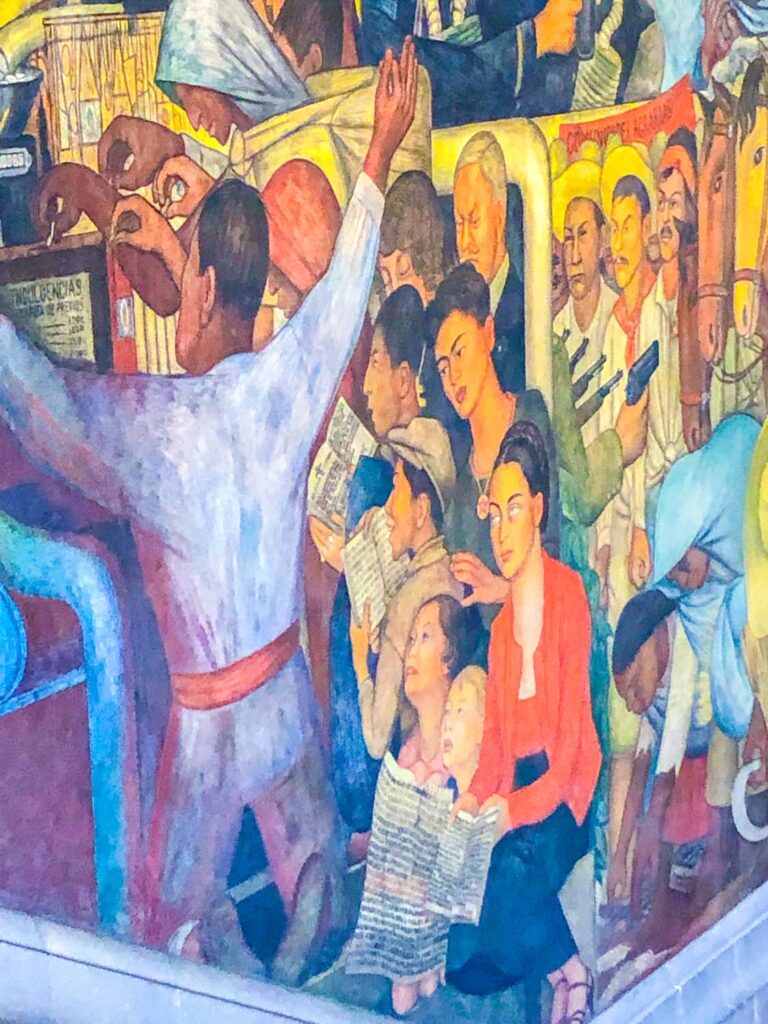
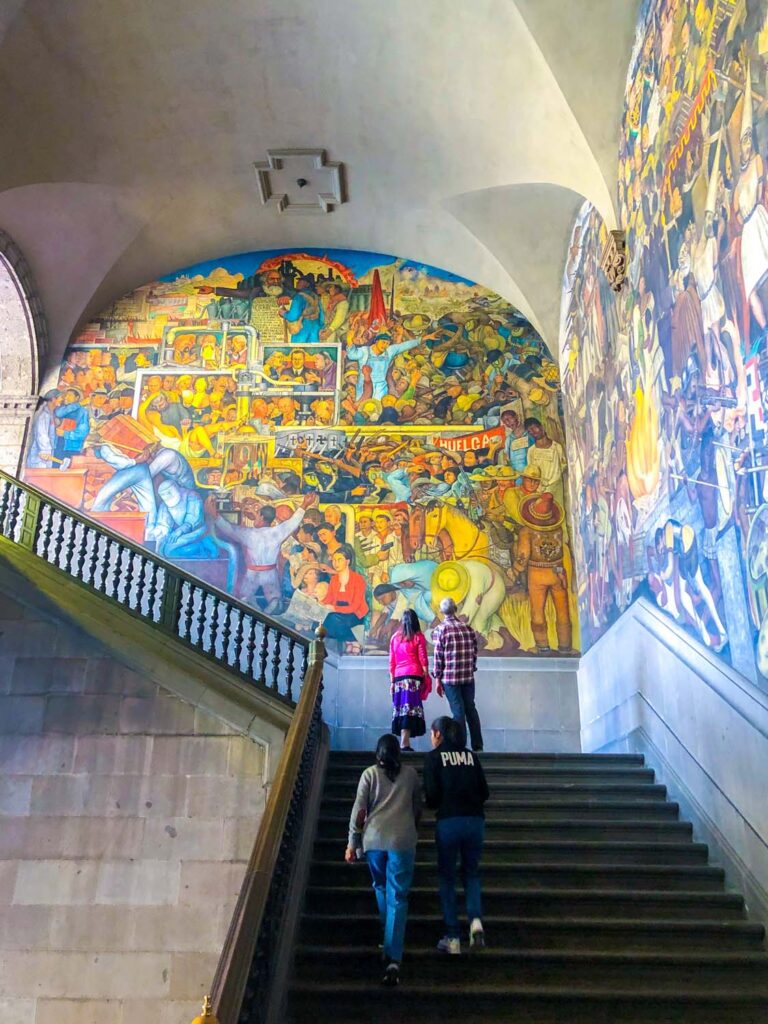
Zócalo
Across the Cathedral is the huge public square, called the Zócalo or Plaza de la Constitución. Every great city has got to have their triumphant main square. Whether it’s St Mark’s in Venice or the Red Square in Russia, you need to have a large central meeting place for your citizens and annual celebrations. The word “Zócalo” means “plinth” or “base.” When the square was first built, there was plans for a large monument to be installed in the center. But only the plinth was ever built. So it began to go by that nickname. The nickname Zocalo caught on for all future public squares around Mexico. Despite them having no connection to an actual plinth on-site they still adopted the name.
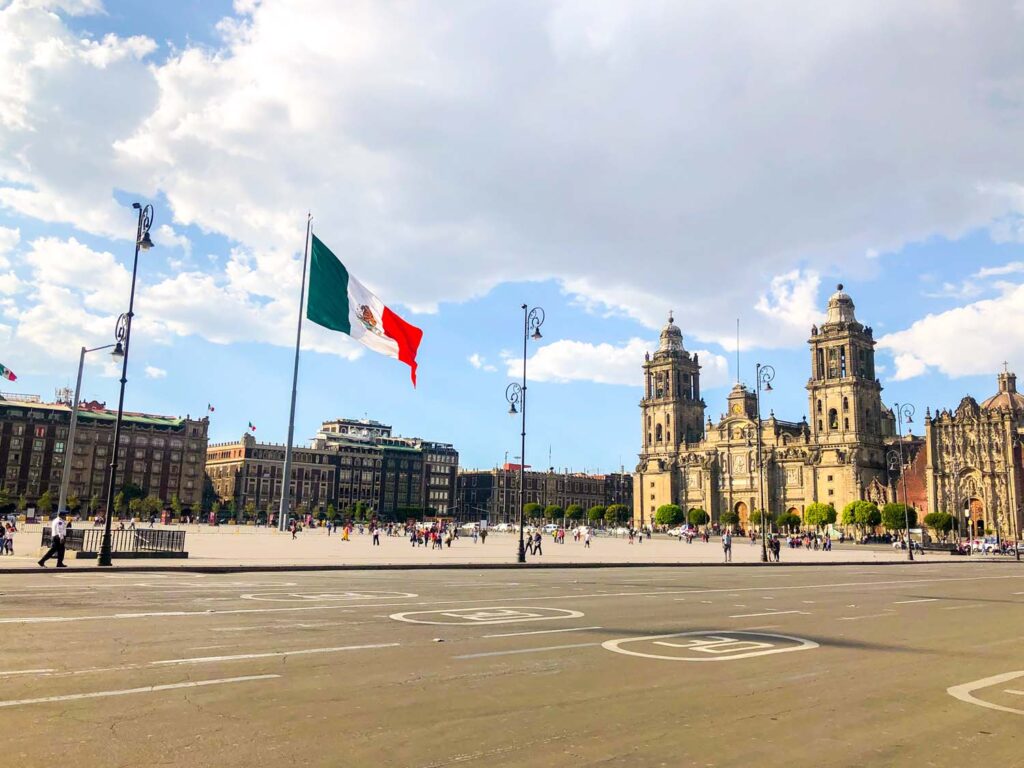
The Aztec Zocalo
Before the Spanish conquest, the square was used by the Aztec people just as they use it today. As an open space for the people. Back then it was surrounded by Moctezuma II’s Palace to the east and the great Templo Mayor to the north. It sat in the center of what was when the intersection of all the roads that met in the middle of Tenochtitlan.
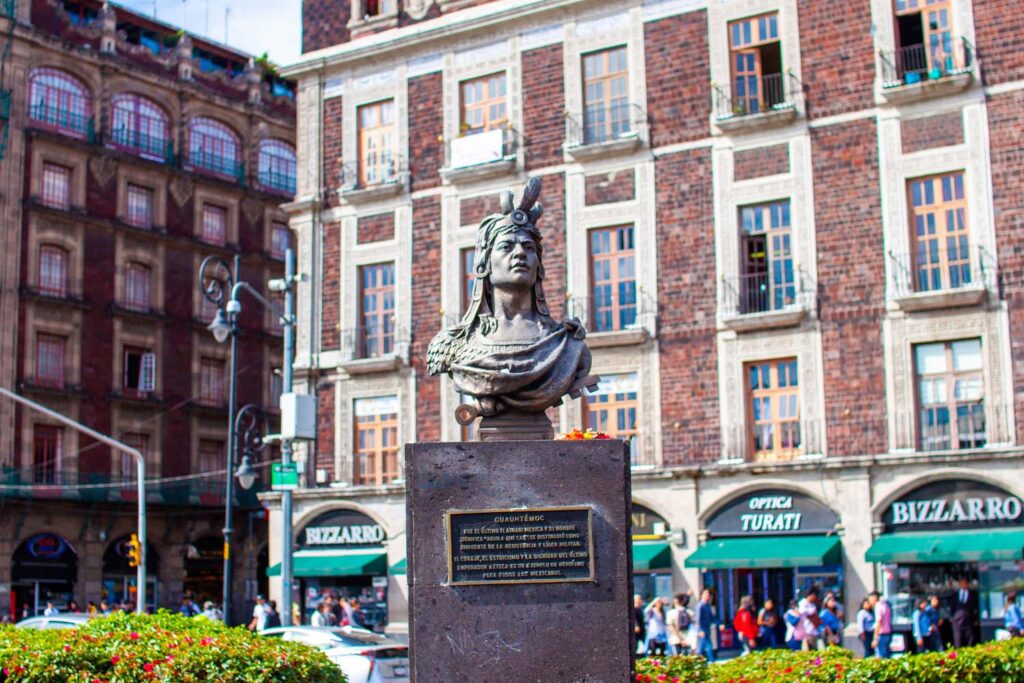
The Spanish Zocalo
Shortly after the invasion in 1521, the Spanish immediately went about transforming the area around the square. But for the most part, they left the Zocalo much unchanged as open-air squares were already famous in Europe and a necessity for big cities. Over the years, market stalls began to pop up around the square. Although I think the idea of a colossal square bustling with vendors sounds exciting, historian Francisco Sedano thought the spectacle was ugly and unsightly. He claimed it was, “very difficult to walk around here at the time because of its uneven pavement, mud in the rainy season, aggressive street dogs, mounds of trash and human excrement tossed among the corn husks and other discarded wrappings.“
Insisting the “unsightly” local vendors should be removed, the government installed a “Parián” in the southwest part of the square. The Parián was a small, stone warehouse where international products, brought in through trade, were sold. This new warehouse meant that local produce and crafts were pushed by the wayside in exchange for foreign products that outweighed the importance of the indigenous Mexican economy. During the Mexican Wars of Independence, the Parián was seen as another symbol of the colonizers. It was target #1 and destroyed during a large riot in 1828.
Celebrations, Rallies and Riots
As the square sits right in front of local government building, it is a popular spot for protests and rallies. But it is equally a place for expression and celebration. Festival de México is an annual event with programs dedicated to Mexican art held in the Zócalo. During the Day of the Dead celebrations, this square becomes filled with orange decorations, colourful floats, music stages, and more!
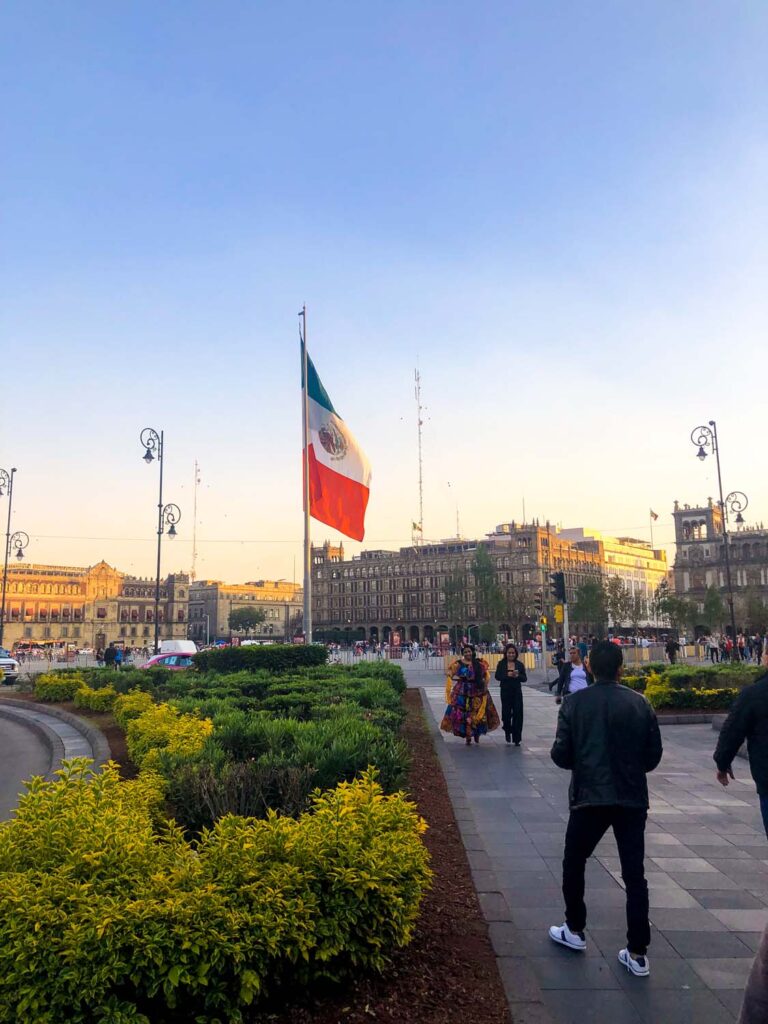
Grito de Dolores
Walk over to the east side of the square to look up at the facade of the Palacio National, which flanks this side of the square. It is here, every year on September 16th, better known as Independence Day, that celebrations start in Mexico City begin. Since 1821, the President of Mexico will walk out onto the balcony on the National Palace facing the square filled with crowds of people.
Once outside, he will ring the bell, which hangs in a small niche above the doorway. This bell once marked the first call to arms during the Mexican War for Independence and it still serves as a call to the people today. The president will then shout out to the people in the square, “Viva Mexico!” A cry echoed throughout the jam-packed Zocalo. This is called the “Grito de Dolores” or”the Cry of Dolores”. While it was once a rallying cry for the end of Spanish rule, today it is a cry for racial equality and the redistribution of indigenous land.
The niche above the bell is topped by a great carving of the Mexican Coat of arms. The niche is flanked on either side by images of an Aztec eagle knight and his Spanish counterpart. Symbols of the ruling dynasties which once occupied the Palacio.
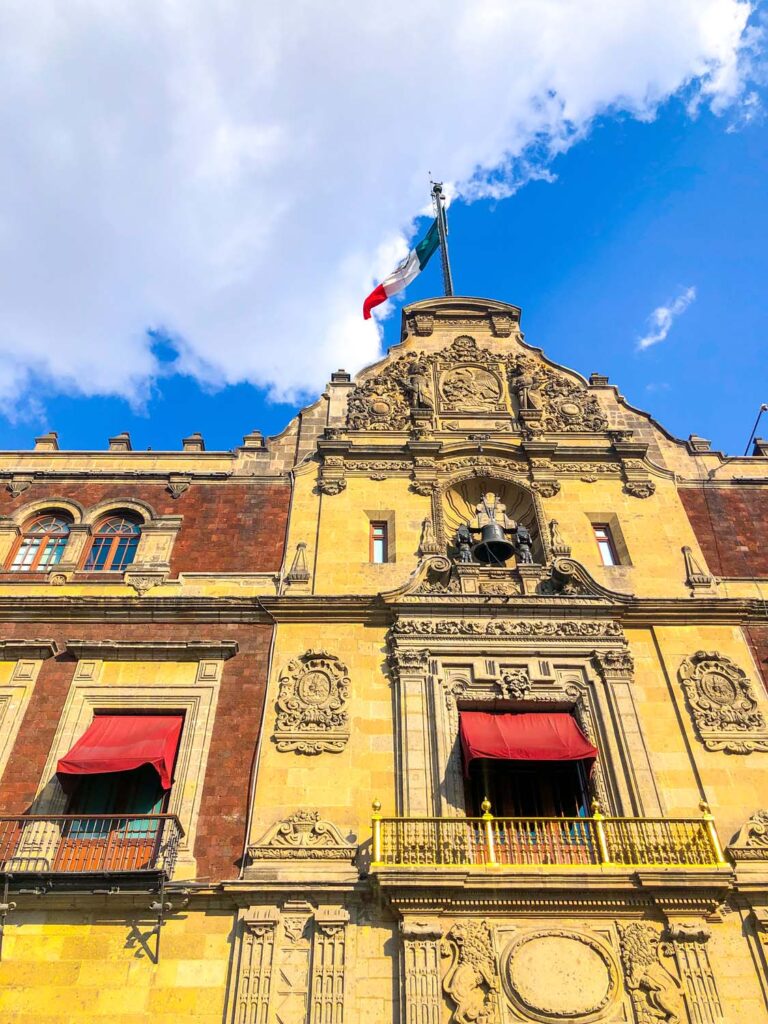
Gran Hotel Ciudad de México
Find your way to 16 de Septiembre Street and walk along, past a few shops, until you find the entrance to Gran Hotel Ciudad de México. Although I don’t generally recommend staying in the Historical Center (mainly because it feels more like staying inside the tourist hub), if you have your heart set on this area of town, THIS is the hotel you MUST choose. The rooms are pretty standard, but you get to stay in this gorgeous piece of history. If you get a room with a view out to the Zocalo, you can’t beat it for people-watching opportunities. The rates are shockingly affordable, so it’s well worth checking out.
While the hotel is adjoined to the larger Old Portal de Mercaderes building, its facade is unique to its location along Septiembre street. The high neoclassical style was preserved along with their iconic green wrought-iron balconies. The origins of the building date back to 1526. Back then, the building was constructed as a residence for the Royal Accountant, Rodrigo de Albornoz. It passed hands a few times through the ages, and in 1895, it was purchased by Frenchman Sebastian Robert. Robert’s had the idea to modernized Mexico City’s shopping scene and built its first large-scale department store right here in 1899.

Centro Mercantil
In this modern department store, named the ‘Centro Mercantil,’ wealthy aristocrats could come and buy everything in one convenient location. Everything from luxurious fabrics, custom hats, expensive jewelry or imported perfumes. The European trend of “high tea” was also brought to Mexico City around this time. Visitors to the Centro Mercantil could enjoy this new trend right there in the opulent lobby cafe. The creme-de-la-cream of Mexico City would be seen walking through the doors, everyone from writers to composers, poets and of course, politicians. It was the who’s who of high society.
Back then, shopping malls weren’t the characterless places they are today. Back then, to draw in affluent customers, department store were lavishly decorated works of art. Robert’s designed the interior in the fashionable Art Nouveau style. Walking inside is like walking into a jewellery box. Hanging above your head as you walk up the stairs is the enormous Louis XV-style chandelier. Its crystals gently tinkling in the wind from the open doorways.
On either side of you, as you emerge from the staircase into the foyer, are two ornate gold canary cages decorated with brightly coloured flowers. But they aren’t just for display, they still hold canaries to this day. Standing in the center of the lobby is the cage-like elevator. This was the first panoramic elevator ever installed in Mexico.
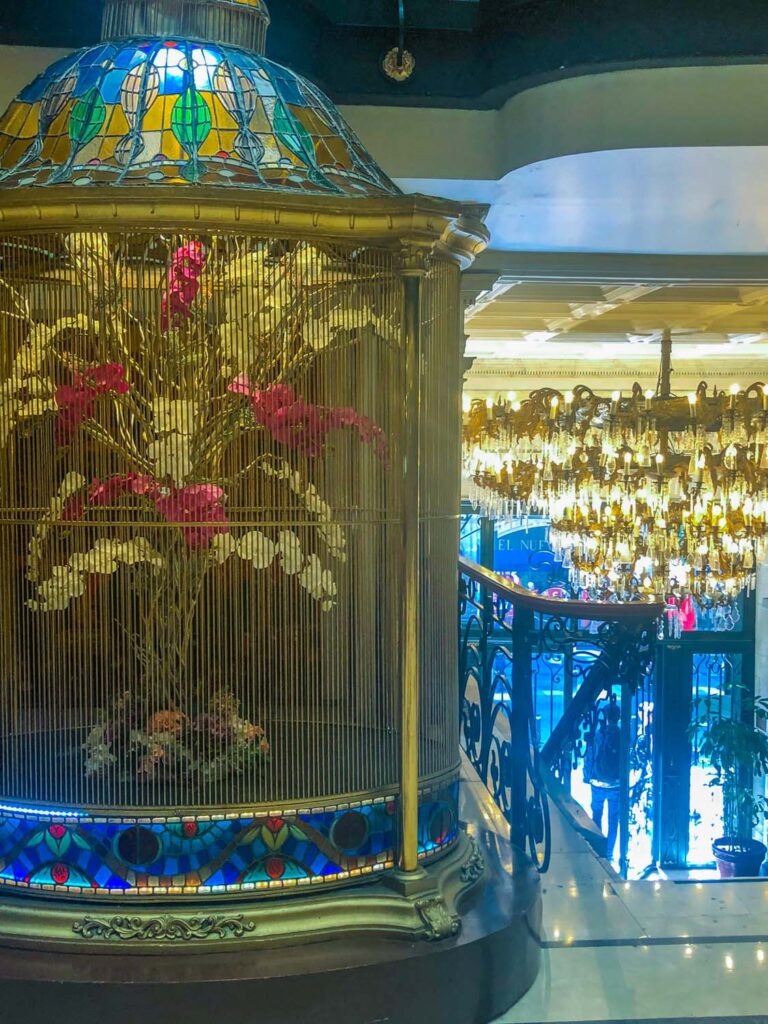

Tiffany Glass Dome
The room absolutely beams with light descending down from the incredible stained-glass dome towering above you. The ceiling was designed by French artisan Jacques Grüber using the illusive Tiffany glass. This is actually one of the four largest Tiffany glass pieces which remain anywhere in the world! Over 20,000 pieces of vibrantly tinted glass were made to create this masterpiece.
Interior
The beautiful wrought-iron railings on the first three floors swell around the lobby like a wave. The use of iron to create the room’s structure was called “Chicago style.” The Centro Mercantil was the first building in Latin American to use the technique. These undulating designs were a replica of the ones inside the famous Au Bon Marché department store in Paris. Au Bon Marché is now lost to time, so the fact we can still see a piece of it today, preserved in this architecture is a real treat. Along the railings, you’ll see the monogram “CM” and “SR” repeated. The “SR” stands for Sebastian Robert, the store owner and the “CM” of course stands for the “Centro Mercantil.”
Conversion to Hotel
The Centro Mercantil officially closed its doors in 1958. It wasn’t converted into a hotel until 1968. 1968 was one of the most famous eras in Mexico City’s modern history when the Summer Olympics came to the country. The Olympics meant thousands of new visitors to the city. To accommodate the crowds, more hotels needed to be built. These hotels were meant to create a positive impression on the international tourists. The city went about finding artful and iconic buildings that could be converted to wow the visiting athletes.
Azul Historico
But my all-time favourite option has got to be Azul Historico. It’s an upscale option but still super reasonably priced considering the quality of the food and the beautiful ambiance. The restaurant is located inside a gorgeous open-air colonial courtyard. You sit amongst the trees while dining on authentic and yet modern Mexican cuisine. The presentation and service is absolutely unparalleled and eating here feels like such a visually sensation experience.
The entire menu is fantastic but one of my favourite hidden gems, that many people might not realize or skip over, is their hot chocolate. Hot chocolate originated in Mexico so ordering it here feels like getting to try the most authentic version of the drink. If you order a hot chocolate, they’ll bring the hot chocolate cart to your table. There, a waiter mixes up your personalized drink. Almost like ordering a fancy cocktail. You get to choose the type of chocolate and even some additives. Then they use these traditional wooden mixers to serve up the cup of warm cocoa right there in front of you! Just one more example of their stupendous service! You really must make it out here!
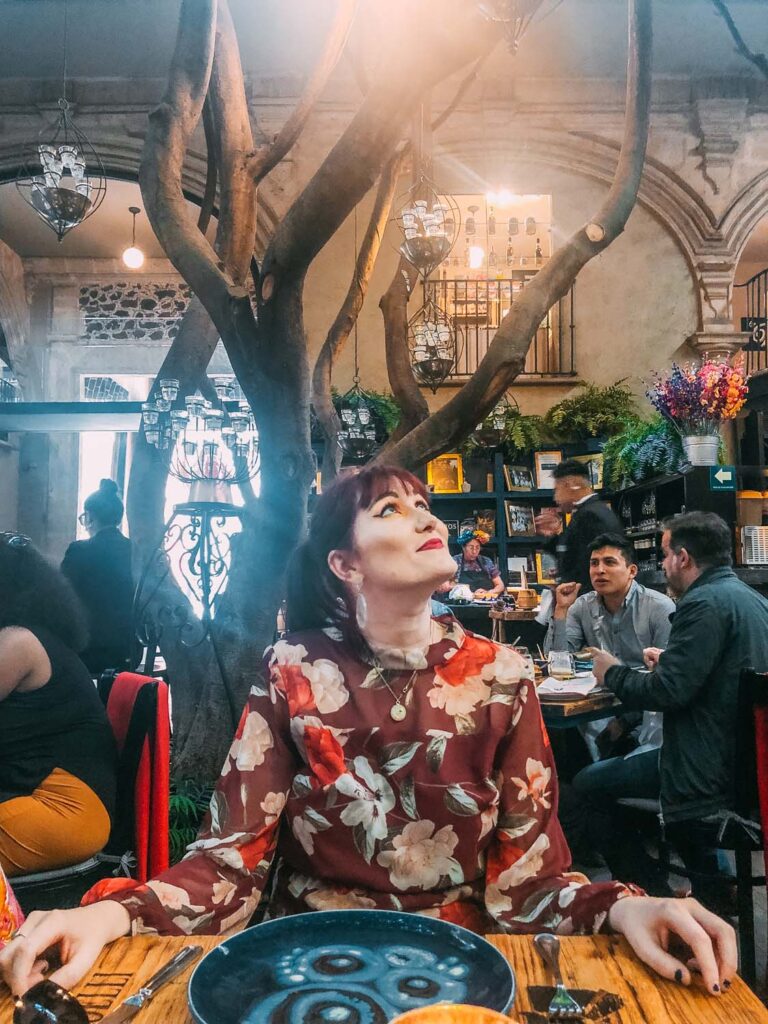
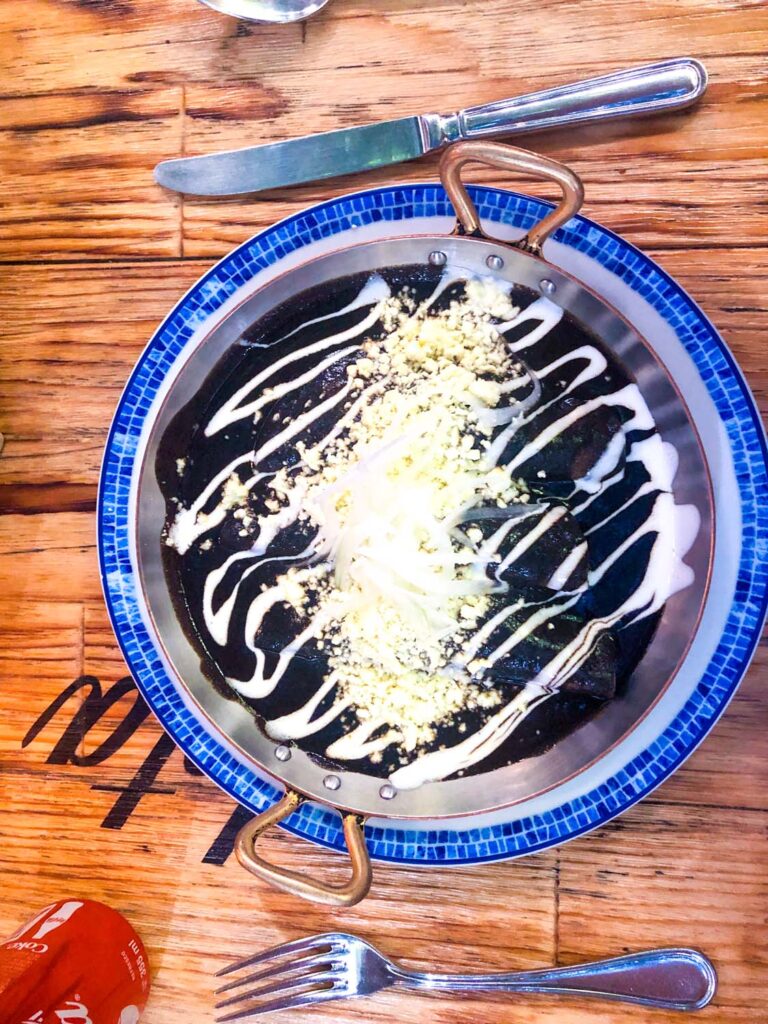
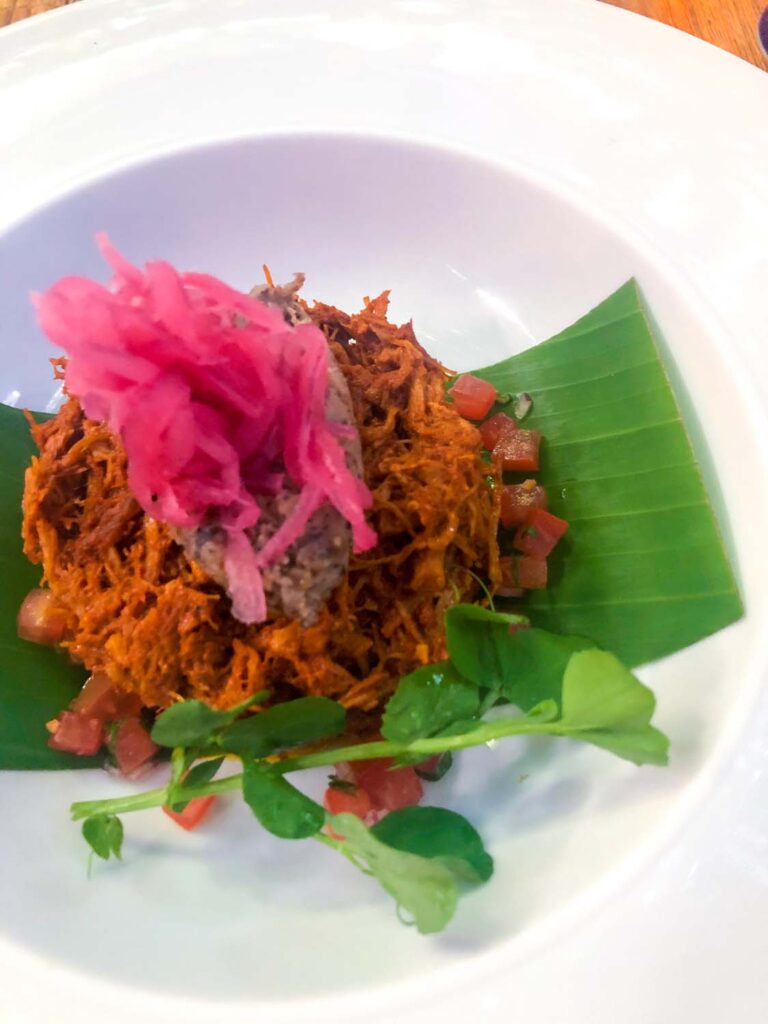
Mexico City’s Historic Centre is a must-see destination for anyone visiting the city. It has so much significance with regard to the history of Mexico. It’s one of the most exciting areas to visit and the museums provide a dozen more reasons to come back! I hope you enjoyed our very thorough tour, time to head home, put your feet up and enjoy a cold Cerveza!
Happy Travels, Adventurers!



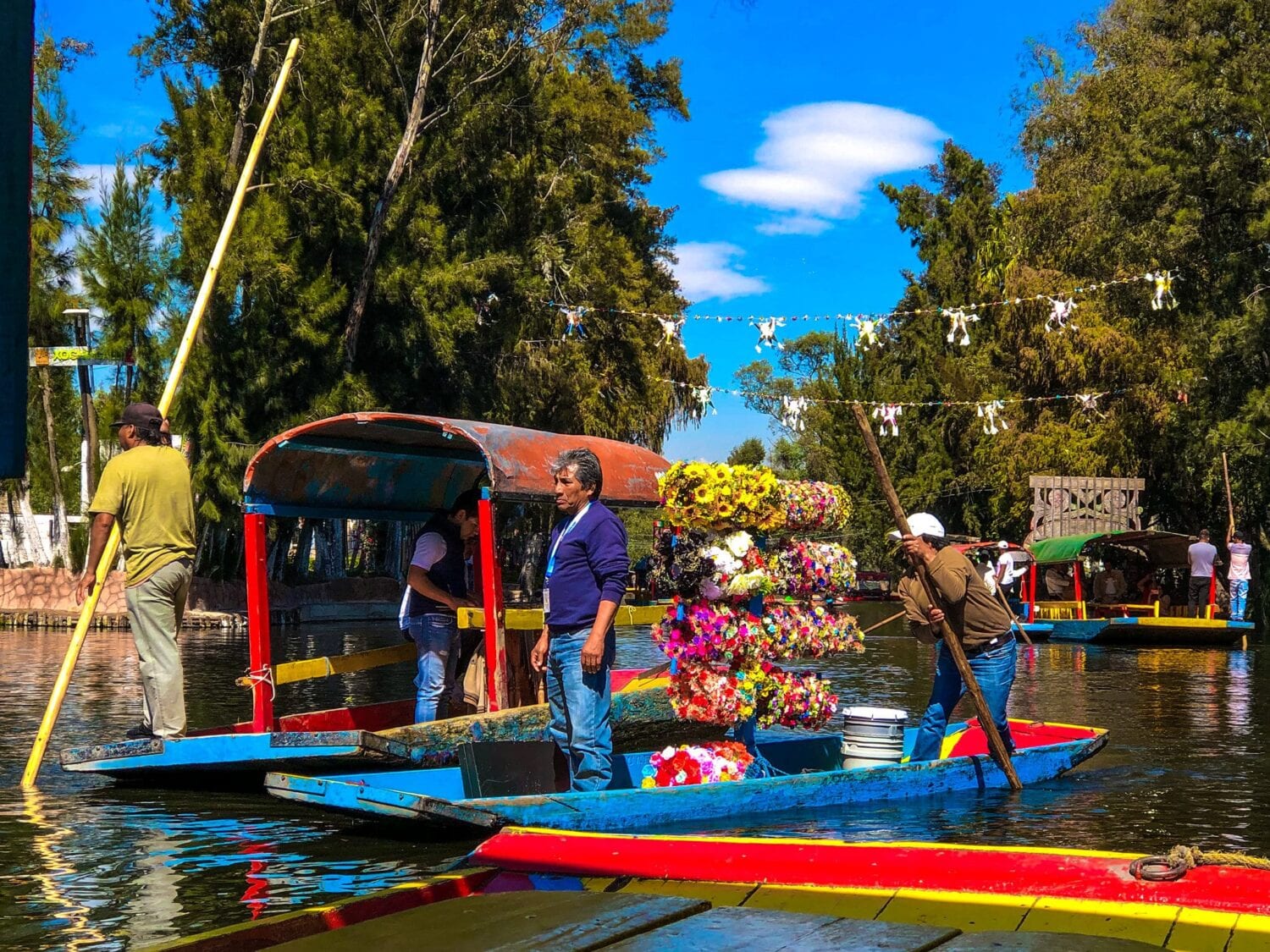
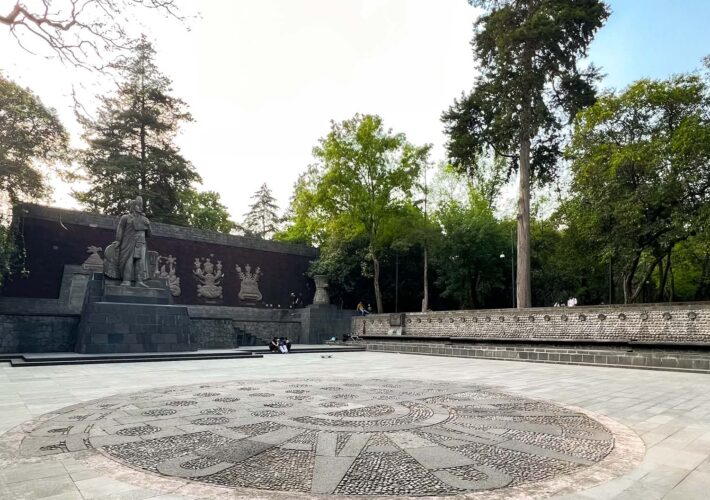
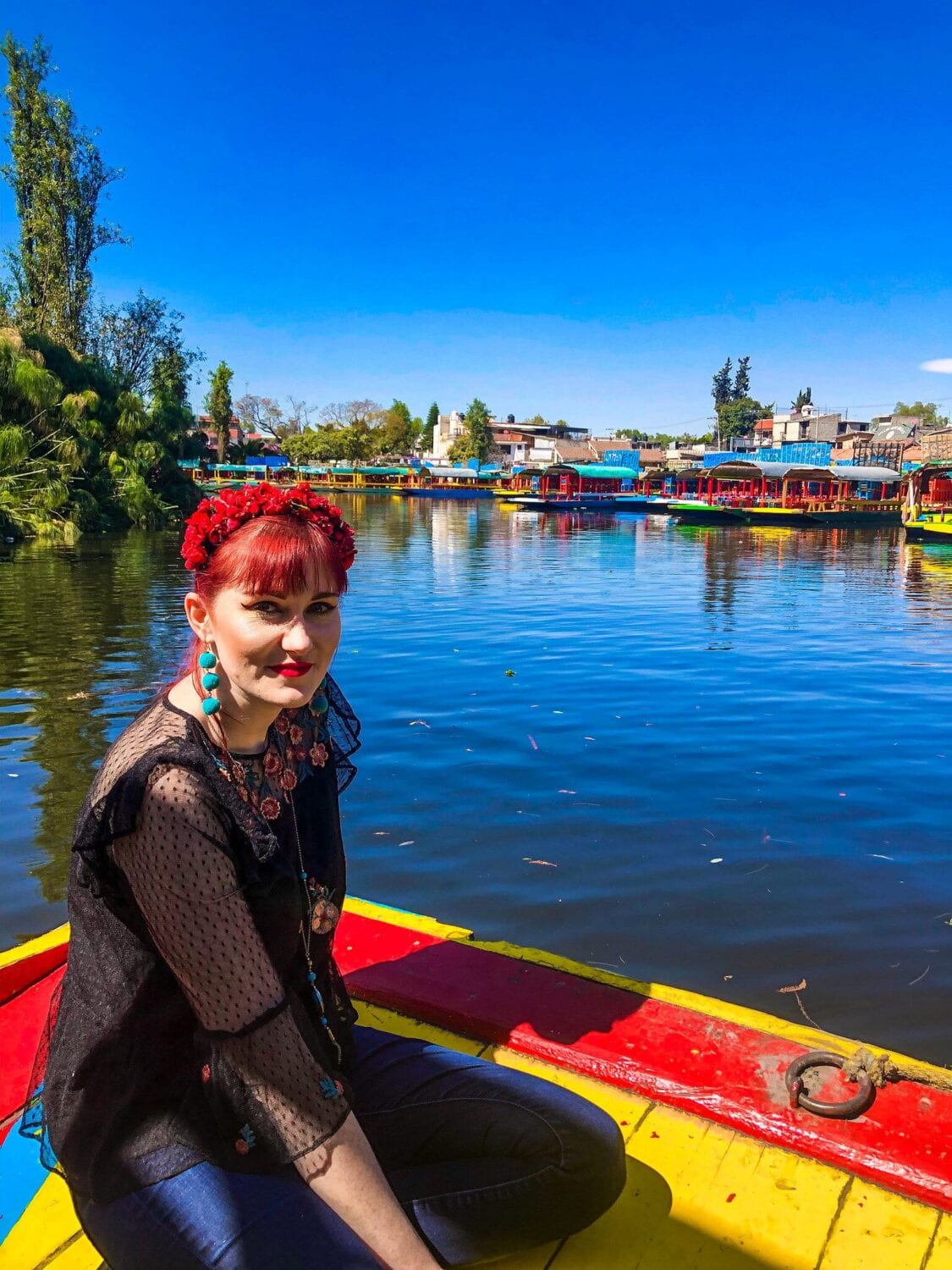
1 COMMENT
D NEALE ADAMS
3 years agoGreat guide